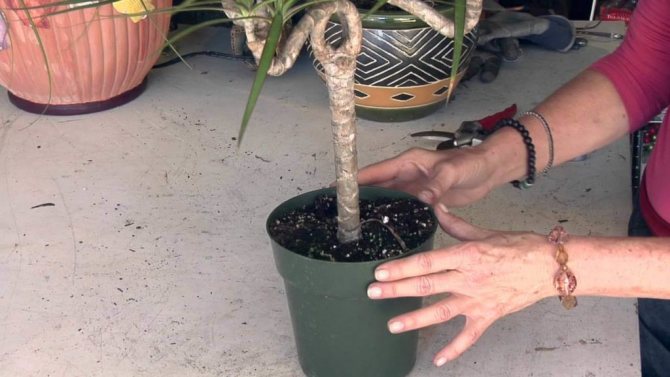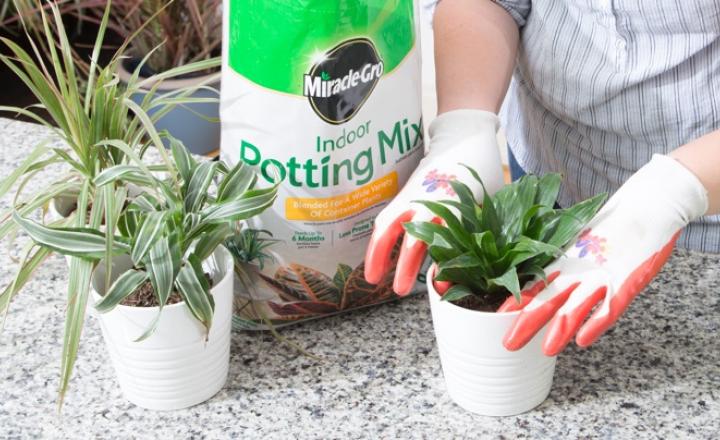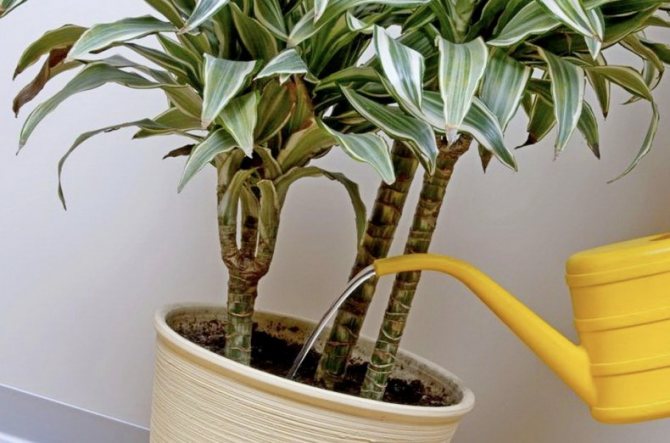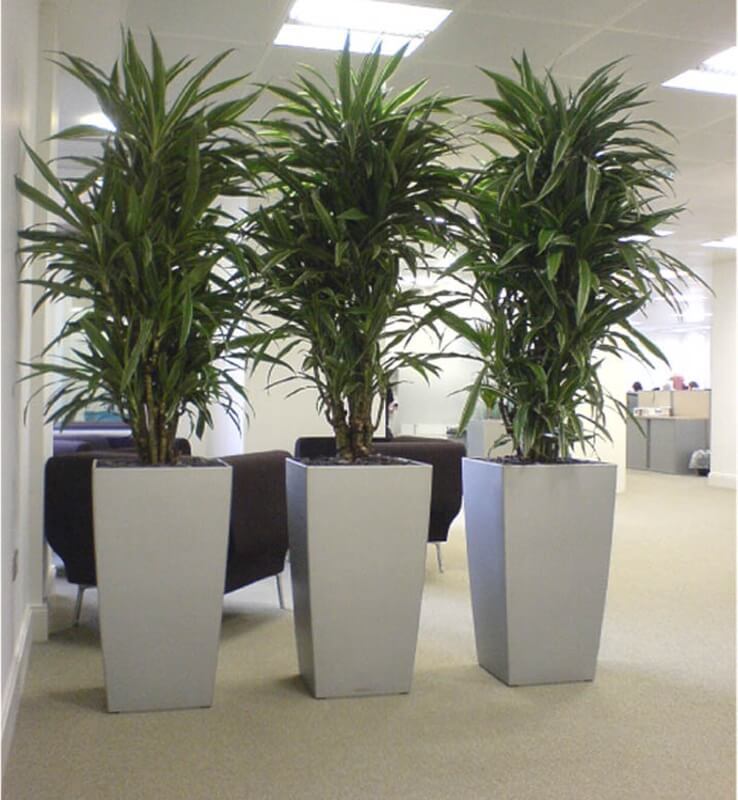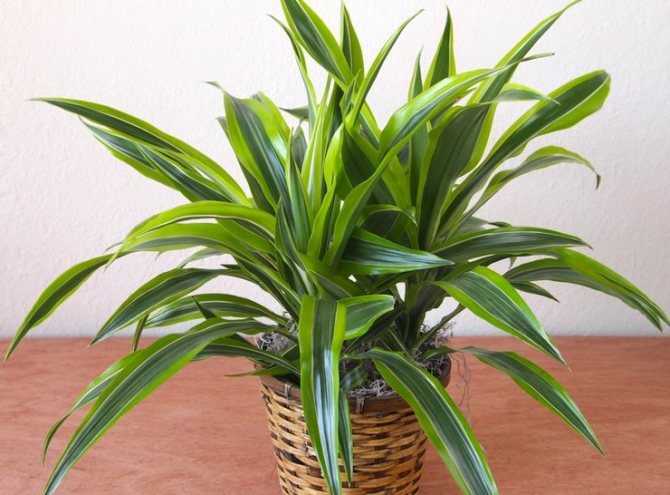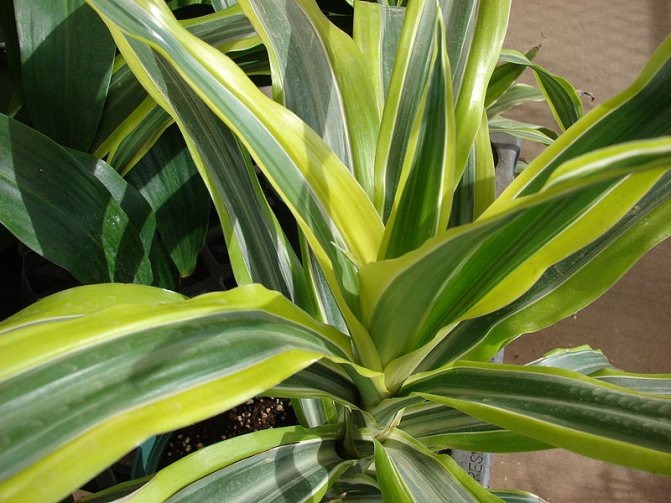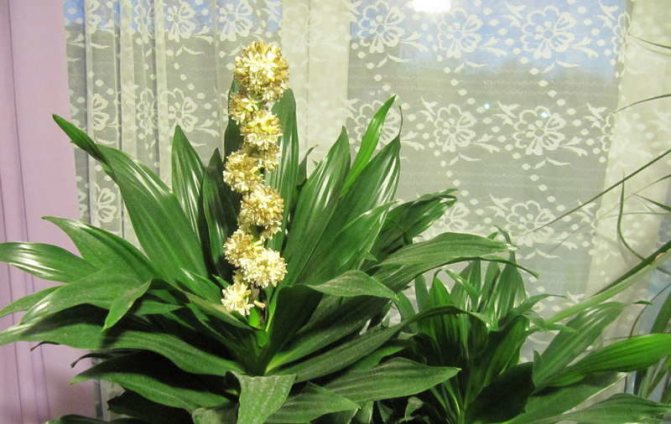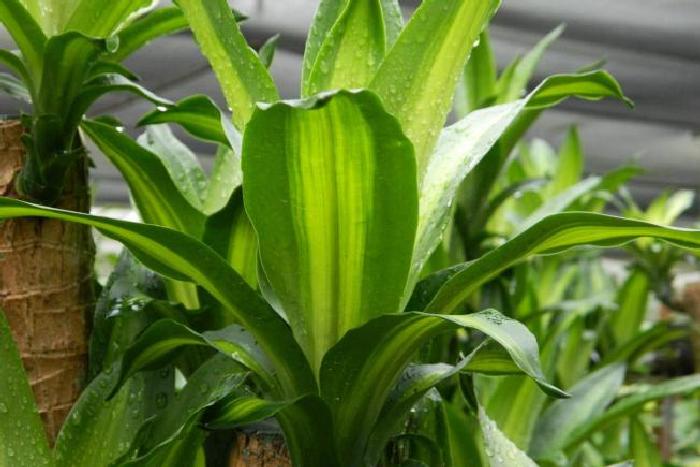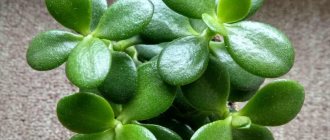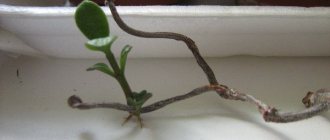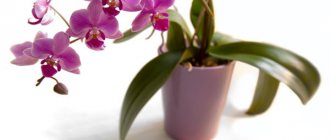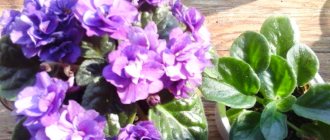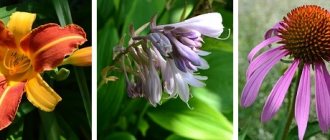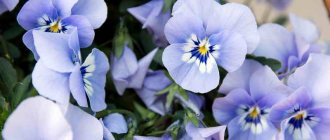Dracaena
Fragrant dracaena is an evergreen shrub plant that, during flowering, exudes a pronounced, fragrant and pleasant aroma. Therefore, it is also called fragrance. Dracaena adapts well to the environment and does not require any special care. This shrub is not only outwardly beautiful, but also beneficial. Thanks to its green foliage, it cleans the air of pollutants.
Details about the plant
Dracaena is recognized as one of the most mesmerizing indoor plants. Stems of young plants are not too branched. They are dotted with leaves, among which there are broad and lanceolate specimens. The color of the leaves is green or with wide and narrow stripes of yellow, pink or white. As it grows, the trunk grows into a solid tree, gets rid of a lot of leaves and looks powerful. In some species, a bunch of leaves is formed at the top of the stem, which gives them an external resemblance to a palm tree. There are species whose leaves grow in a spiral. Dracaena roots are compact. They are red-yellow in color on the cut and do not form overgrowths.
The growth of dracaena takes a fairly long period, but they live a long time. This flower can produce panicles with light pink or white flowers with a pleasant scent. But, as a rule, they rarely bloom indoors.
Dracaena flower has a pleasant smell, looks like a panicle with light pink or white flowers.
Among indoor florists, dracaena is in demand due to its unpretentiousness and extraordinary beauty. It is often used as an element that decorates and complements the interior. The plant also looks amazing in a flower arrangement. Dracaena will easily fit into large and small hallways, halls, halls of hotels, shopping centers, offices.
The described plant is a fairly common indoor flower. He does not need careful maintenance, easily perceives moderate fluctuations in air temperature, in comparison with other flowers, it normally tolerates watering, which can be carried out irregularly. Dracaena is able to feel good, grows not only in daylight, but also under electric light.
The plant is considered exotic, capable of bringing joy to the house at any time of the year.
Plant features
Fragrance can bloom in two types of flowers: white flowers or small light green flowers. On the peduncle, which reaches 1 meter, fluffy inflorescences bloom. Fragrant flowers with their smell attract various insects. But indoor dracaena bloom very rarely.
Fragrant dracaena in indoor conditions usually grows to a maximum of 2 meters. The length of the leaves reaches 60 centimeters, and their width is 10 centimeters. The color of the leaves is green, they have pronounced stripes and veins, which come in different shades, usually from light green to yellow.
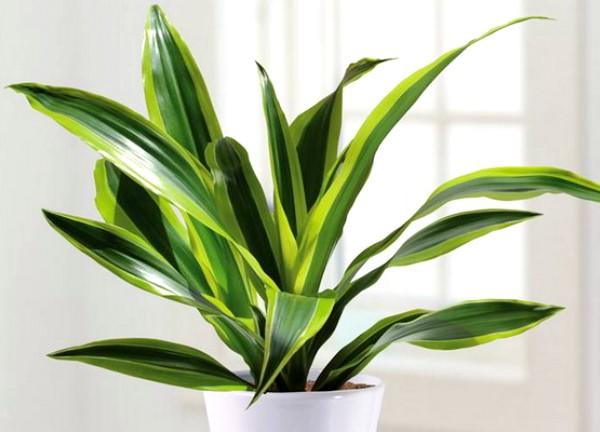
Dracaena fragrant care is especially important when the plant begins to hurt. The disease can develop due to poor conditions or parasites. For example, the tips of the leaves may begin to dry out if the plant lacks moisture. Also dracaena fragrance is afraid of drafts and too dry air.Conversely, in a very humid room, the leaves begin to turn yellow and wither. Direct sunlight is also dangerous for the flower.
Fragrance can get sick from the attack of parasites, such as: mealybugs, aphids, spider mites, scale insects. In order to prevent the attack of these parasites, it is necessary to carry out prophylaxis that will protect the flower. To do this, it is important to regularly wipe the leaves with a damp sponge so that dust does not accumulate on them, as well as wash the flower under a warm shower.
When are cropping manipulations performed?
The plant will feel comfortable and look healthy if it has reached a considerable height. From the first months of spring to the end of August, the dracaena is in the stage of active growth. It is this period that is considered the optimal time to perform pruning.
Trimming the dracaena trunk stimulates the development of lateral buds, after which the branching process begins.
The procedure for circumcision for dracaena is not very pleasant in the cold season. In winter, it is inactive, so experts do not recommend disturbing the flower. Even if all actions are carried out without deviating from the rules, there is a high probability of a variety of problems, and, as a result, the dracaena may die.
In summer and spring, the plant produces hormones responsible for its growth. Thanks to this, there is a quick recovery of the trunk. During the winter months, hormones are not produced, which makes the healing process much slower.
Pruning a flower during periods of slow growth is possible only in emergency situations, for example, if it breaks. Damaged dracaena should be cut off immediately. If a broken dracaena, pruned in winter or autumn, undergoes proper resuscitation care, then it will quickly recover and will continue to delight the owners with its appearance.
Is dracaena circumcision allowed when it is in a weakened state or is affected by some kind of disease? Absolutely not. Only a plant filled with vitality can cope with a stressful situation when pruning. The owner must take care to completely heal his plant. If you cut off an unhealthy dracaena, then the cut area will gradually begin to dry out or rot. It will be extremely difficult to save a flower in such a situation.
Top dressing
For plant growth, nutrients are needed. Dracaena gets them from the soil, but over time they can run out, which slows down the growth of the flower.
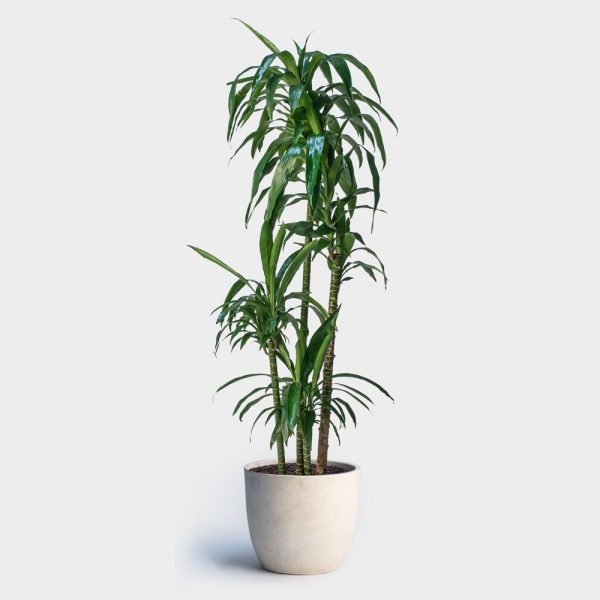

Therefore, it is important to apply fertilizer. Fertilizer is applied in the spring. Use mixtures that are designed for evergreen flowers. As a rule, it is foliar, by spraying foliage.
After feeding, the leaves become bright and shiny. After such treatment, the flower survives the transplant process more easily.
Action Tips
Any part of the plant can act as a cutting: the top, the leaves themselves, and parts of the trunk.
The pruning procedure is essential for all plants without exception. It perfectly performs the function of stimulating the kidneys, due to which new branches appear. However, not all indoor plant lovers consider it necessary to prune it. Why is this procedure important? The plant often produces deformed shoots. To ensure a beautiful appearance that will delight others and decorate the room, pruning of a sanitary-formative nature is performed. Instead of shoots with external defects, the dracaena sprouts new shoots.
It should be borne in mind that an overgrown houseplant does not look decorative and refined. After the pruning procedure, the flower will again look well-groomed and healthy.
Sanitary pruning is done if the dracaena is affected. Those parts of the plant that are infected with various pests or organisms must be removed without delay.The faster the operation is performed, the less likely the disease will spread to healthy areas of the flower.
To do this, you need to prepare a knife, the blade of which is well sharpened. The height of the section of the stem to be cut can be selected at your own discretion. The most suitable height is considered to be 15-20 cm from the top end. Use a sharp knife to cut off the stem.
Activated carbon treatment avoids rotting of the cut area.
Part of the cut off trunk should not be thrown away. This piece is suitable for plant propagation by cuttings. The trunk should be dried for 2 or 3 days. As soon as the edge is tightened, it must be placed in a container of water or thrust into moist soil. There it should be until it takes root.
Dracaena, which has taken root, needs to be transplanted into a vessel for constant growth. Drainage is laid at the bottom of the container with a flower. We must not forget that the vessel with dracaena must have a special hole at the bottom.
The cut area must not rot. This can be avoided by treating the damaged area with activated carbon or paraffin. Activated charcoal tablets should be pre-crushed into powder. Melt the paraffin in a water bath. When processing, you need to be extremely careful so that the paraffin does not harm the delicate leaves.
Pruning should be done again if the stem in the damaged area begins to rot and other measures do not help.
Cut dracaena loses moisture in a short time. Because of this, the formation of new kidneys is inhibited. To avoid this problem, experts recommend spraying water on the stem several times during the day. The water should be at room temperature.
For greater benefit and to create comfort, the plant should wrap the damaged area with slightly damp sphagnum moss. On top of the flower, you need to put on a colorless plastic bag so that the moisture leaves more slowly. Every 3-4 days (within 7 days) you need to lift the bag from the flower and find out what is happening with the shoot, moss the moss. Such actions will allow the dracaena to form new shoots quickly enough.
The container with a houseplant should be in a dark and always warm room. The optimum air temperature in the room is 27-28 ° С, in no case lower than 25 ° С. It is necessary to pay attention to the elimination of drafts at the location of the pot.
New kidneys form for a long time (over 30 days). When the first bud appears, the flower is able to take care of itself on its own, so you can safely remove the sphagnum. Shoots on dracaena will begin to form in 60-90 days.
Dracaena is considered an exotic houseplant for a reason. She fascinates with her appearance and attracts the attention of almost all amateur flower growers. To keep a flower beautiful and healthy, very little is required from a person, but the plant will decorate the room for many years.
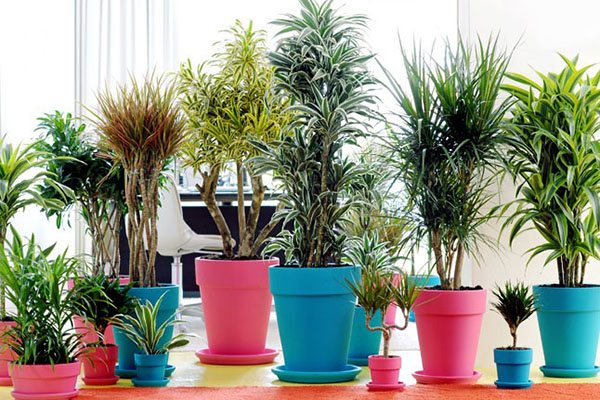

Dracaena grows at home for up to 15 years. In this case, the evergreen plant grows with its top, and the lower part of the stem is bare. The leaves, having worked for a little more than a year, gradually dry out, leaving a scar on the stem. How to prune dracaena to get side shoots? The plant allows you to create new forms by shortening the shoots.
Growing rules
For fragrant dracaena, it is important to create a favorable atmosphere and provide proper care so that it feels comfortable.
When choosing a place where to put a flower pot, you need to focus on a comfortable room temperature. Dracene fragrance is best kept in a room where the air temperature is 19-25 degrees. Cold for these flowers is contraindicated. You should not leave the flower indoors where the air temperature is below 14 degrees.If it is too hot outside or at home, it is necessary to provide additional watering to the fragrance.
It is also important to take care of good lighting for the flower. It is worth choosing a well-lit room. If the windows face the southern side, you do not need to put a flower pot near the window, since constantly falling sunlight negatively affects the development of dracaena. This evergreen shrub loves fresh air, so in the warm season it can be taken outside or on the balcony. But, again, make sure that the sun's rays do not fall on it.


Basically, fragrant dracaena tolerates dry air well, but from time to time its leaves can be irrigated with water. If the flower is constantly in a room with dry air, it is necessary to spray it with water 1-2 times a day so that the leaves do not turn yellow and do not fall off.
In the warm season, it is necessary to water the flower quite often. But you cannot fill it, otherwise the roots will begin to rot. For good air exchange, the soil should be loosened at least once a month. If a salt deposit has formed on the ground, it must be removed, and a new substrate should be poured on top.
Watering during the cold season should be moderate. But, given that it can be hot in apartments when the heating is on, watering may need to be the same as in summer.
It is best to replant these plants in spring, since their dormant period lasts from October to January. If the young plant was purchased in a transfer container, then it must be transplanted into a permanent pot. Adults fragrant dracaena are transplanted every 2-3 years.


Since a dormant period begins in winter, feeding is not needed, and the rest of the time the dracaena can be fed with special means about 1 time per month.
How to properly trim dracaena at home
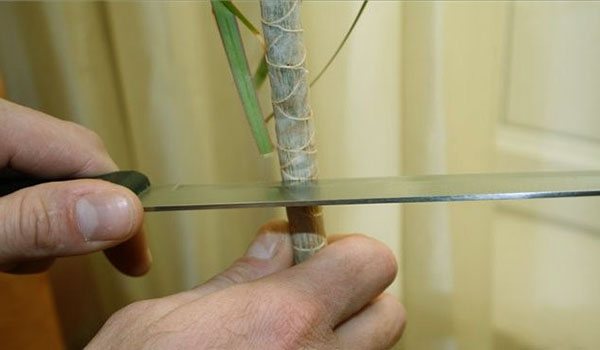

When shortening the central stem, you need to take into account several points:
- the top with green leaves should be in the zone of comfortable lighting, so the height of the trunk is calculated for the future growth of branches and leaves;
- for the emergence of new shoots, it will be necessary to provide the necessary conditions for the germination of new shoots from dormant buds;
- all operations for making the correct cut, sealing it are carried out under sterile conditions.
You can use a plant for pruning that has 30 cm from the soil to the attachment point of the upper leaves.
Any part of a leafy or bare trunk is cut off. The remote area can be rooted by getting another copy of the dracaena. Cutting dracaena for branching as an operation is carried out with a sharp knife without squeezing the tissues.
After the top of the plant has been cut off, it can be used to root the top, or cut into 7-10 cm shafts, each of which is capable of producing a new plant. The requirement to cut with only a sharp knife and even cuts is mandatory.
If the stem is leafy at the cut, the leaves must be removed by 10-15 cm, exposing the trunk. Cover the cut site with garden varnish or molten paraffin so that the inner layer does not evaporate moisture and does not dry out. The rudiments of new branches should form on the cut. There can be from two to five of them. But not all rudiments will grow. The number of new formations depends on the conditions in which germination takes place.
Achieved the simultaneous development of all new shoots due to uniform illumination. Dracaena must be turned during germination and subsequent care.
Germination conditions:
- treatment of the stem with water with the addition of a growth stimulant, for example, Epin;
- creating a wet moss cushion around the open cut of the cambium, the waxed part should be open;
- a plastic bag is tightly strengthened from above, creating a constant humidity of 75% inside;
- in the light at a temperature of 22-25 degrees, the plant is kept for a month.
It is important at this time not to open the cut site, not to remove the package, not to change the germination conditions.At the same time, the remainder of the leaves requires watering, the stem also needs to be moistened. Watering is carried out only in the bottom method, draining the remnants of water that has not been absorbed into the earthen lump. It is important that germination is carried out in the light.
As soon as the plant begins to germinate at the cut site, it is ready to continue development without additional shelter.
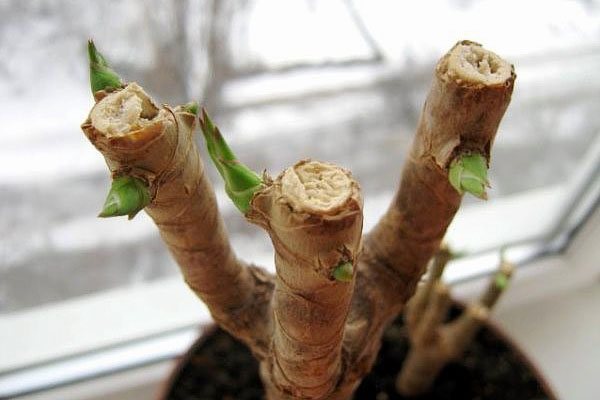

It is not necessary that new branches will develop from all the buds that have hatched. Some will run out of food and dry out. But you can cut the plant like this many times, updating it and giving it a new shape.
If the plant has a bare stem, then it is completely placed in the bag after abundant watering. The bag is not removed before the emergence of seedlings, so as not to disturb the microclimate. The plant is watered through the pallet.
When forming a dracaena, bordered seedlings can go along the stem anywhere. Then the palm tree will become multi-tiered.
Helpful care tips
When growing garden or ornamental plants, the experience of professional gardeners is very important, therefore we offer you some general recommendations that will help in the care and preservation of the decorative properties of dracaena:
- To prevent the tips of the leaves of the tree from drying out, always control the level of humidity in the room and the absence of drafts.
- Soft and curled leaves may indicate hypothermia of the plant, and often just one night spent in a cold room is enough for the appearance of these symptoms.
- Even if you are growing sun-loving dracaena varieties, it is best to protect them from direct sunlight, which can lead to dry light spots on the leaves.
- When rooting cuttings in water, always add an activated charcoal tablet there, which will protect the root system from decay.
- The lower leaf plates of a tree under normal conditions look good for 2-3 years, so if they began to turn yellow earlier, it is worth revising the lighting regime and the level of humidity in the room.
- An overly bright color of the leaves sometimes indicates an excess of nitrogen fertilizers or a lack of light, therefore, before looking for the cause in other features, it is worth considering this possibility.
- Good branching of dracaena is facilitated by high humidity and a sufficient amount of light, but in some cases this is not enough. Be sure to consider the type of plant, because, for example, Sander's dracaena is always characterized by limited branching.


In general, planting and further caring for dracaena cannot be called a very difficult task, so with a responsible approach to the growing process, even a novice gardener can easily cope with it.
Is pruning dracaena required at home
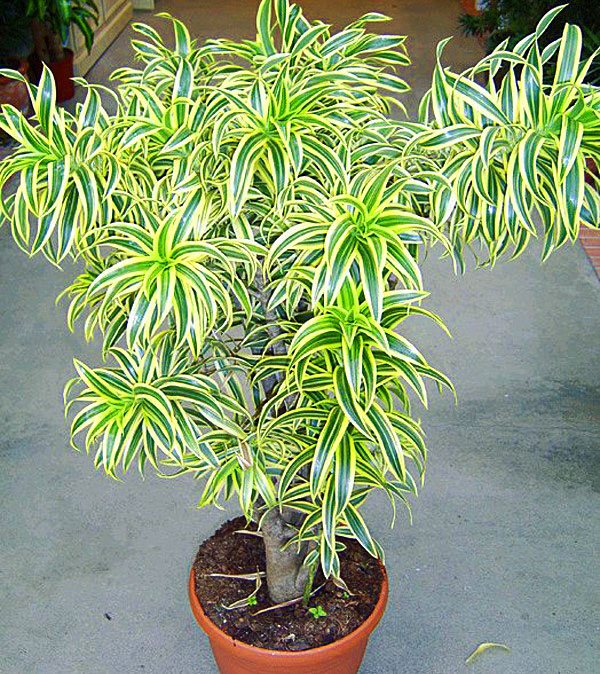

A plant looks well-groomed if it is pruned and shaped regularly. Therefore, pruning is one of the mandatory operations for caring for dracaena. It happens that the plant has deformed shoots, they should be removed. Then, instead of them, the plant will start up new shoots, more foliage is obtained, the plant takes on new forms.
Any areas with pests and diseases should be removed immediately to prevent contamination of the entire plant. This operation is called sanitary pruning.
Video about the result of pruning dracaena
All palm-type indoor flowers need pruning, but not everyone knows how to properly prune dracaena, for example. Similar actions are carried out when the branches are young, and only with a healthy plant. Withered, drooping leaves are a sign that nothing should be done to shorten the stems, this can lead to the complete death of your pet. Buying a ready-made plant, it is already a formed palm, consisting, as a rule, of two branches. From this moment, its formation begins at your discretion.


Plant diseases and pests
Like any other plant, dracaena is not immune from pests and various diseases, which are often caused by mistakes in caring for a tree.
Most often, flower growers have to meet with the following problems:
- Alternaria - characterized by the appearance of pale brown spots with a light center, which can be scattered not only over the leaves, but also along the trunk of the plant. Over time, the tissues in such places die off and the leaves wither.
- Heterosporosis - manifests itself in elongated light areas with a red border, which are further tightened with a greenish-gray bloom.
- Bacteriosis - the tips of the leaves acquire a dark brown color, and small rounded "ulcers" are formed on the trunk and petioles. Healthy tissues are usually separated from the affected tissues by a wide yellow stripe, slightly oily to the touch.
- Fusarium - characterized by the appearance of yellow areas on the plant (from bottom to top), with a "watery" border along the contour of the leaf. The upper part of the trunk fades quickly, and the trunk itself becomes thinner and dries up. In some cases, fusarium leads to the spread of brown spots throughout the plant.
- Wet (bacterial) rot - well visible on watery spots on all parts of the plant, which eventually lead to complete soaking of the affected areas.


Unfortunately, this is far from a complete list of possible ailments of dracaena, so you should not be surprised if traces of gray, brown rot or brown spot appear on the tree. In some cases, the plant also suffers from powdery mildew, which manifests itself as a brown bloom on the leaves.
Find out why dracaena leaves dry and turn yellow.
As for pests, when growing dracaena, you often have to deal with such parasites:
- Shield (leaves behind round brown spots on the seamy side of the leaf and can lead to blackening of the soil in the pot).
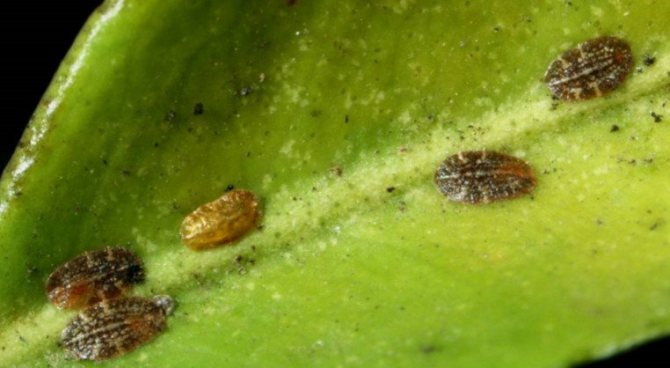

- Spider mite (it is easy to recognize it by thin, almost transparent threads, densely braiding the petioles, as well as by brown dots on the seamy side of the leaf plate).
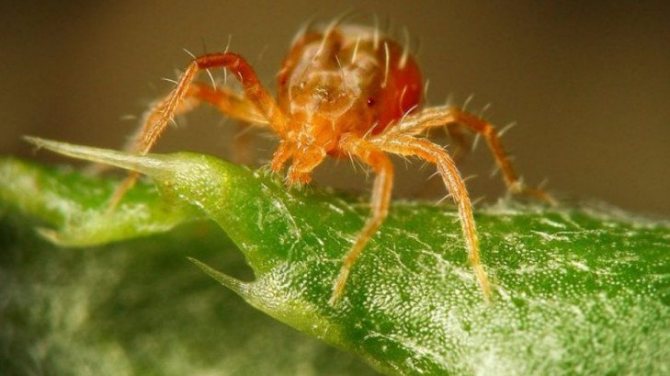

- Thrips (discolor the plant and leave small black dots on the seamy side of the plant, sometimes complemented by thin silvery scratches).
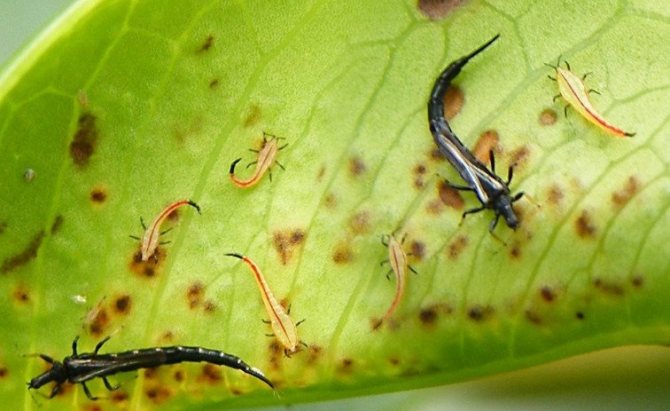

- Aphids (if you look at the dracaena under a magnifying glass, you can see significant colonies of small insects densely clinging to the seamy side of the leaves and the upper part of the trunk).


- Mealybug (leaves small clumps of gray plaque in the axils of the leaf plates, because of which they quickly turn yellow and dry out).


Each individual problem has its own methods of solution, most often consisting in the use of insecticidal (for example, Iskra-Bio, Calypso, Aktelik) and fungicidal (Quadris, Fitosporin-M, Fundazol) drugs ... It is also possible to process dracaena with self-prepared solutions and decoctions, but the use of folk recipes should be approached very carefully so as not to burn delicate tissues and aggravate the situation.
Did you know? According to its medicinal properties, dracaena juice is equated to the juice of the famous aloe; it has antioxidant properties and can be used to strengthen the heart muscle and the human immune system.
What you need to know about dracaena
Dracaena (sometimes Dragon) belongs to the Asparagus family and has up to 150 species. Popular species that are often found in our country are Dracaena fragrant, bordered, bent, deremskaya, godsefa. Outwardly, it is similar to a room palm, therefore, the required care for it resembles a palm tree. Loves temperatures 18-20 degrees, frequent spraying and wiping. Well-lit rooms are welcome, however, the scorching rays of the sun leave spot burns on the leaves. The tree is fed once a year from March to August.
Preparing for landing
Before planting the dracaena, in addition to the seedling itself, you will also need a suitable substrate and a pot.Also, we must not forget that we are talking about a tropical variety, which means that you should make sure in advance that all the necessary conditions are in your home.
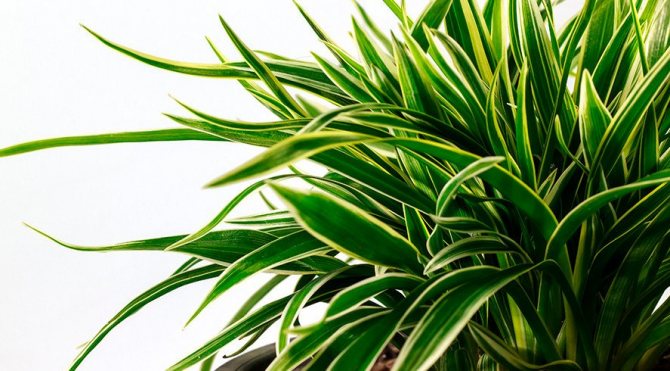

Optimal growing conditions
Whatever type of dracaena you decide to grow in your home, any of them will require a sufficient amount of sunlight, which is why it is better to place exotic pots on the south side of the house. At the same time, in extreme heat, it is advisable to move plants with dark green leaves to the shaded part of the apartment, otherwise spots will appear on them, and they will no longer look so attractive. Bright green specimens, on the other hand, are very fond of scattered sunlight and calmly endure even the brightest exposure.
Why and when to cut dracaena
What for? Dracaena pruning gives a start to the formation of new outlines, dense foliage without the formation of "bald", long trunks.
When? During the active period of growth, during sap flow. Sleeping buds in a spiral cover the entire trunk, which awaken only after it is cut.
An exception. With minor damage or complete breakage of the trunk, it becomes necessary to shorten the bush.
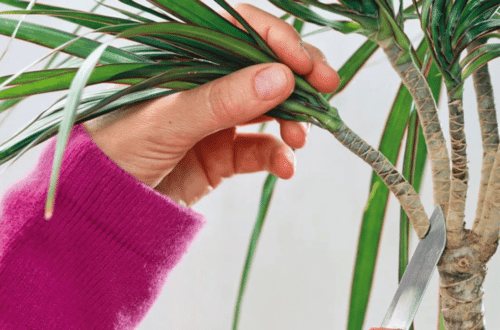

Photo gallery
Dracaena formation. Filling the cut with paraffin.
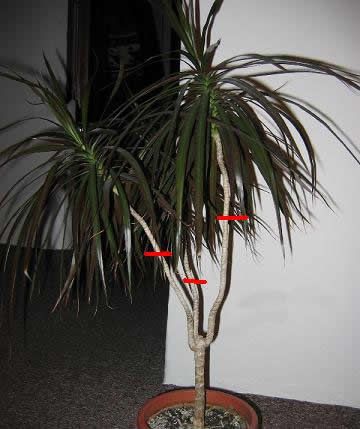

It is unpretentious in care, the only aspect that can cause difficulties in its cultivation is pruning, which must be carried out regularly.
Features of pruning dracaena
When shortening the main trunk of a succulent shrub, it is necessary to take into account the following features of how to cut a dragon tree at home:
- The stem needs pruning, the bare part of which has already reached 30 cm.
- The procedure should be carried out with a sharpened knife.
- The entire length of the plant can be cut into 10 cm cuttings and new dragons can be grown.
- If the stem to be cut has leaves, they must also be shortened by 10 cm.
- To preserve moisture, cuttings are covered with paraffin, garden varnish, wax.
- You should be aware that not all rudiments will sprout.
- In the process of germination, the shoots must be periodically rotated along with the vessel in which they are located. This is necessary for uniform light penetration and for germination of all shoots.


Varieties
Dracaena fragrant exists in several varieties. The most common are Compacta and Massangeana.
Variety Compact has dark green leaves, without veins and stripes. Only one cultivar, Compacta Variegata, has light yellow stripes on the leaves. The trunk is lignified, the leaves are collected in dense bunches. The plant looks very stylish and elegant.
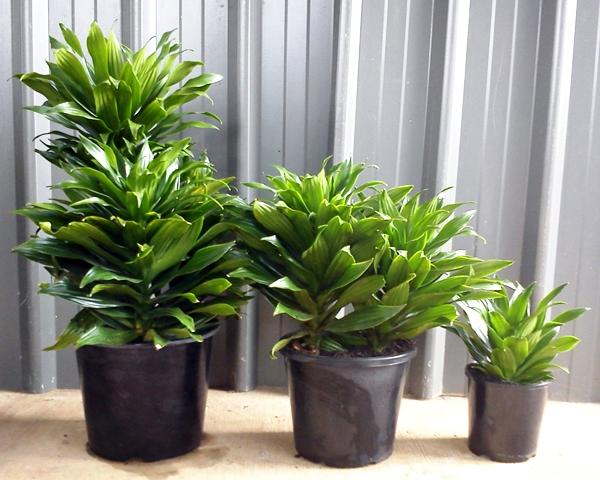

Massangeana grows up to 1.5 meters, has a palm-like shape. The color of the leaves is variegated, in the middle of the leaf there is a clearly delineated wide strip. The length of the leaves reaches 60 centimeters; in the process of growth, they gather in a bunch at the top of the trunk. This variety is distinguished by its special endurance among its relatives. One of the positive properties of this dracaena is that it is able to cleanse the air from harmful substances, and also humidifies the air. This variety has very fragrant and beautiful flowers in nature.
There are also many different varieties that differ in the shape of the leaves, their color and size. And depending on the variety, the height of the dracaena fragrance is also different. The genus of these evergreen trees and shrubs has about 150 species, but about 40 species of these plants can be grown at home.
Some of the rare varieties of indoor dracaena are: Lemon, Surprise and Kanzi.
In flower shops you can find fragrant dracaena called Mix. The suffix Mix means that the plant is a sort of Dracaena fragrance. You can find out which variety it is thanks to the characteristic features of the leaves, the height of the tree or shrub and the shape of the trunk.
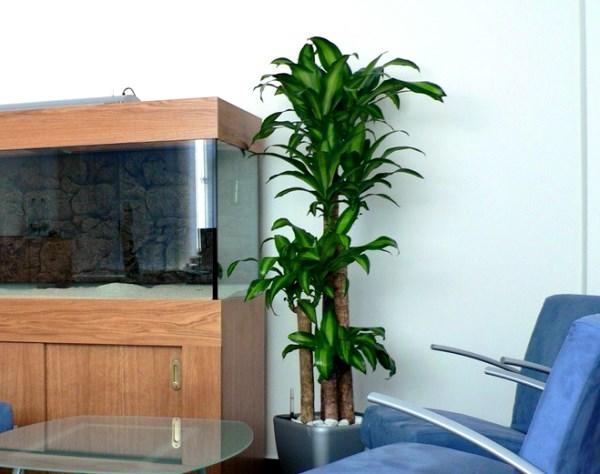

How to prune dracaena for side shoots
An elongated bush with a bare trunk does not look attractive. You need it to branch.Below is the sequence of how to prune dracaena to obtain side shoots:
- Decide on the place of branching.
- Cut off the stem strictly horizontally with a sharp knife. Can't be broken.
- Expose the area below the cut about 15 cm from the leaves.
- Cover the resulting section with wax or powdered charcoal.
- Wrap the moss over the remaining piece, leaving out the waxed cut.
- The entire structure must be constantly in a humid environment until buds appear. This environment can be achieved by constantly wetting the moss or by covering the trunk with a plastic bag.
- The moss wrap should be removed as soon as the bud appears.
Humidity
It is important for dracaena to maintain air humidity. If there is dry air, then the tips of the leaves begin to dry. Batteries provide especially dry air during the heating season. Therefore, the flower should stand at a distance of at least 1.5 m from them.


To reduce dryness in the room, hang wet towels on the radiators. It is helpful to regularly spray the plant with water at room temperature.
How to decorate a tree
Fluffy dracaena is the result of pruning and leaving not a single day. You can grow a bush in several trunks by planting cuttings in one pot. In the process of growth, the roots harden and intertwine with each other, requiring more capacity. Splendor can also be achieved by installing a horizontal insert between the stems.
It will take a lot of time to decorate a dracaena, which looks like a palm tree. The apical cutting from the mother plant develops very slowly.
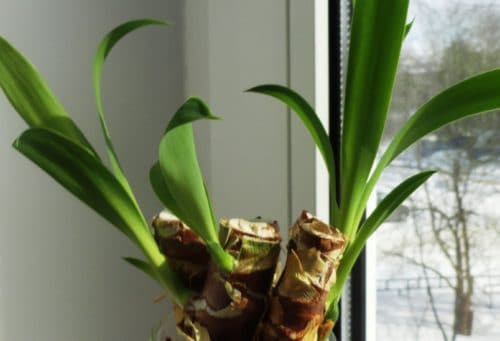

Possible pruning problems
- After pruning, in some cases, the buds never wake up. It is necessary to re-trim, making the cuts a few centimeters lower than the previous ones.
- The cut site in one or more areas (central trunk and side shoots) begins to rot. Immediately you need to re-trim, removing all rotten parts.
- Some buds are stunted. You can activate their development by spraying the emerging shoots with carbamide (an aqueous solution of urea - 1 g / l) or making an aqueous solution of a growth regulator by adding micronutrient fertilizer (2 drops of epin + 2 drops of cytovite per 250 ml of water). Zircon is more suitable for stimulating flowering. After the procedure, gently blot with a napkin so that the solution does not stagnate in the axils of the shoots and does not cause burns in the plant.
It is not difficult to grow a plant that looks like a palm tree at home - the dracaena is undemanding to care for. The owner needs attention and timely watering, proper lighting and timely pruning. ...
Is it possible to get a thick trunk
A thin and fragile trunk can break if handled carelessly, and all your labors will collapse in a moment. Therefore, building it up in diameter is an important achievement. In order to get a thick trunk, you should adhere to the following points:
- Mandatory feeding.
- Bright, non-scorching light.
- The air temperature is 18-25 degrees.
- Do not allow the soil to dry out.
In winter, when the temperature is lower than the set one, it is necessary to reduce the frequency of watering.
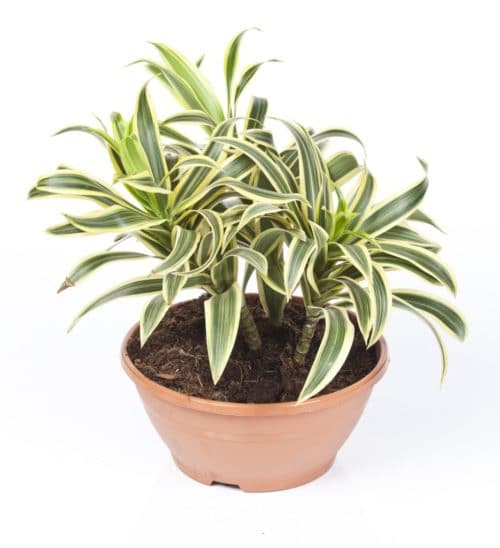

Temperature
Many people think that tropical plants love heat, but this does not apply to dracaena. The ideal temperature is from +5 to +25 0С. In winter, it is worth maintaining the temperature no more than +15 0С, and the rest of the time you can provide +20 0С.
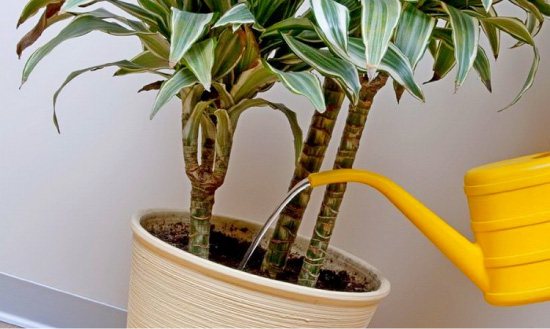

Many growers have found that the temperature of +11 ° C is easier to tolerate than +30 ° C. When airing the room, the plant should not be placed in a draft, as this negatively affects it.
In the summer, you can take the plant out to the balcony or put it on the street. But there, too, it is worth picking up a place, they do not put in the wind.
Bansai from Dracena
Pruning is exactly the procedure that will help grow a dracaena that mimics a bansai. Getting such a tree is not a matter of a single year.Tips for forming a multi-stemmed cascading dracaena bansai tree:
- A five-year-old dracaena with a trunk diameter of 5 cm is ready to form a bansai.
- Several shoots should hatch under the cut, further growing upward. This will cause the trunk to thicken.
- The foundation has been laid, now it all depends on what kind of tree you want to see in the future. After a while, new overgrown trunks can be cut close to their base.
- Repeat pruning on the next branches.
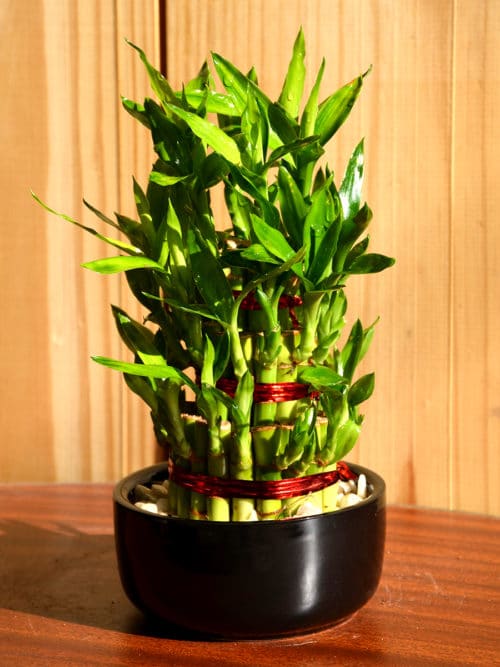

Dracaena varieties
The genus includes more than 40 species, of which a dozen are used to decorate premises. They are diverse in appearance, shape, parameters, foliage color. The most common plant species are:
| Dracaena marginata | It is also called bordered due to the presence of a border framing the edges of the leaves. It is one of the most common forms with green leaves and a red stripe on them. The leaves are long, can grow up to 70 centimeters and are narrow, slightly curved. At home, it practically does not bloom. The peak of decorativeness occurs in adulthood, when the trunk is completely freed from the lower leaves, and the top is decorated with a bunch of leaves that are unique in their appearance. The older the specimen, the more it resembles a palm tree. It can grow up to 250 centimeters in length. If the leaves are slightly damaged, the plant may not start to grow well, so the right place for the flower must be chosen. |
| Dracaena fragrans | They are diverse in parameters (it can be dwarf up to 20 cm and high - up to one and a half meters), the color of foliage and stripes. There are yellowish-green or yellow foliage. The leaves are wider than those of the previous species, curved in an arc. The flowers are white or pale green. |
| Dracaena deremensis | It belongs to the category of tall plants, even in a room it can grow up to 3 meters. The trunk is thick and stiff. The lower leaves dry up and fall off, exposing the trunk and leaving characteristic marks on it. The leaves reach a length of half a meter and a width of 5 centimeters, widened towards the base. The color is dark green, variegated. In young plants, the leaves grow upward, in older plants, they droop. The flowers are dark red with a protein core. The smell is not very pleasant. Berry-like fruits, orange. It rarely takes root at home. |
| Dracaena sanderiana | Shoots can be found in specialty stores called "happiness bamboo". But this plant has nothing to do with bamboo. Graceful trunk, small growth (up to 1 meter), long dense leaves, slightly curved, green with gray or white stripes. Practically does not bloom. It looks great in small spaces. |
| Dracaena reflexa | It is an ornamental plant, very demanding to care for. The three-meter barrel is straight, so you need to make a support for it. The leaves are small, variegated, arrow-shaped, green. A yellow stripe runs along the edge of the leaves. Prefers rooms with high humidity than dry ones. |
| Dracaena godseffiana | Rarely found among indoor plants. More like a small shrub with straight, thin bases pointing up. Leaves are oblong, eleptic, slightly pointed, grow up to 5 pieces. Above, the leaves are green with light specks. Godzefa blooms with fragrant, greenish-yellow flowers. |
| Dracaena arborea | Looks great in any tall room. The tree-like representative reaches a height of 12 meters. The leaves are long (up to 1 meter) and wide enough (up to 8 centimeters), green in color. |
| Dracaena hookeriana | It grows no more than 2 meters. Sometimes the trunk can split in two. Garden varieties are bred. Grown in warm greenhouses. Leaves up to 80 cm long and up to 5 cm wide, covered with skin. At the base they are wavy and slightly tapering. The edges are white. |
Dracaena care rules
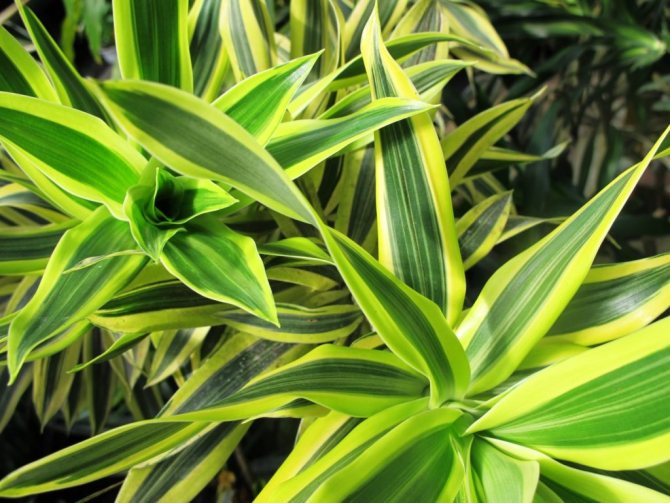

The plant is quite capricious, and the conditions in which other indoor plants can grow and develop may not be suitable for it. Consideration should be given to the recommendations of experts in the industry.
Lighting
Dracaena grows where there is constant "sea" of sunlight. She doesn't just love the sun, she needs it. However, it is uncomfortable for her to develop in direct sunlight, since in nature it is shaded by tropical forests. An excellent place for a flower will be located in close proximity to the east window or next to the south window. When purchasing Dracaena with variegated foliage, it is worth considering that she needs more diffused lighting. In winter, Dracena needs artificial lighting.
Temperature
A warm room is preferable for a plant than a hot one. In the summer, she feels great at temperatures from +20 to +25 degrees, but for a short time it can develop at higher temperatures. In the winter months, the indoor temperature should not drop below +15 degrees.
On warm days, Dracena can be taken outside or onto the balcony. The only condition is the absence of drafts.
Moistening the soil
Dracaena loves water very much, so when watering, you should not save on it. Despite the strong love for water, you should not overdo it, as the earth can bloom. If water begins to stagnate in the root system, then the flower may disappear. Therefore, it is necessary for yourself to determine the regularity and volume of watering. In the winter months, Dracena should be watered with settled warm water with longer breaks than in the summer.
Spraying rules
The house palm loves not only water, it prefers to be in a room with sufficient humidity. Dracaena loves water showers very much. Rare species can tolerate constant dry air. The plant should be regularly sprayed with warm water or wipe the leaves with a soft sponge or flannel cloth.
If the air is too dry, the tips of the leaves will begin to dry out and acquire a yellow tint. Brownish specks may even appear. This suggests that the plant needs to be sprayed.
The quality of the soil mixture
Dracaena is completely indifferent to the composition of the soil. She doesn't care what kind of soil she is placed in. But the optimal composition for a plant is considered to be a mixture of leafy earth, turf, sand and peat. The main requirement for the land is sufficient looseness and water permeability. The bottom of the pot must be covered with a substantial layer of drainage.
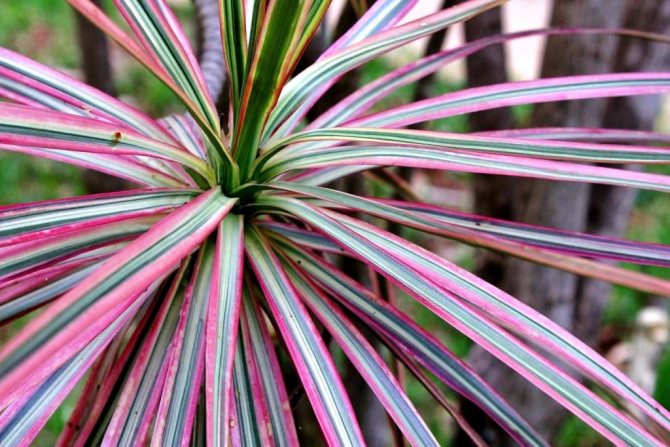

Fertilization
Dracaena needs to be fed, but not too often. The optimal period is every week or twice a week. Can be fed once every 30 days. Most of all, the plant is pleased with complex liquid mineral fertilizers, which are applied from April to August.
Reproduction
Transplantation and reproduction activities are usually the same. This mostly happens once every three years. Young Dracaena is transplanted annually, and the old one is transplanted every 5 years. In the process of transplanting, there are many unnecessary shoots that can be used for germination and rooting. The upper part of the plant takes root better than the rest. If the tree has grown to such a state where the trunk is completely freed from the lower leaves, it should be rejuvenated. It does this by cutting off and rooting the apex.
Air layers and cuttings are also propagation methods. In order for the young to take root, it must be placed in a soft earthy mixture. You can add some moss to the ground.
Possible transplant errors
With proper preparation for the dracaena transplant process, no problems should arise. At the same time, plants are considered more vulnerable, which at the time of removal from the pot were severely dehydrated or, conversely, excessively flooded with water that did not have time to be absorbed into the soil.The next 2 weeks after transplanting, the palm tree will actively adapt to new conditions, which is often accompanied by the loss of leaves. This is a completely normal process, but if the problem does not disappear after 2-3 weeks, then you will have to re-analyze your actions.
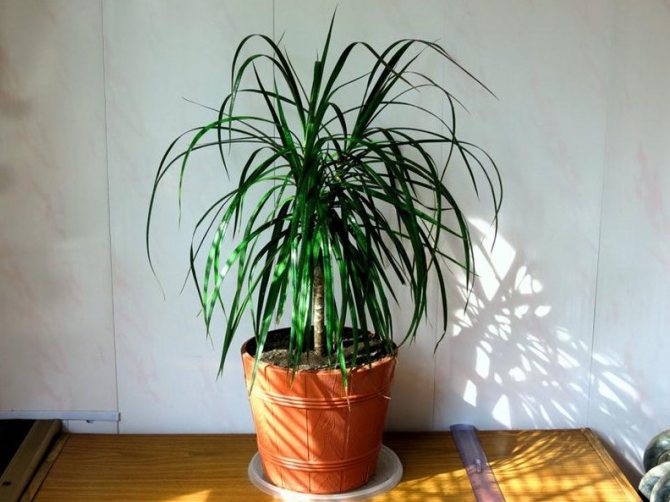

Typical mistakes made by florists in this case include:
- Improperly prepared substrate, with an excess of peat and other components that repel moisture. Only transplanting into new, properly prepared soil will help to correct the situation.
- Using an oversized pot because of which moisture stagnation is often observed and, as a result, rotting of the plant root system. If you notice the problem in time, then the dracaena can still be saved by transplanting it into a smaller container with a new substrate.
- Excessive watering immediately after transplanting. This is a typical problem for beginner growers who try to water the plant abundantly without waiting for the previous portion of moisture to be completely absorbed. The next watering should be carried out only after the soil dries out 1-2 cm deep. Removing the earthen clod from the pot and drying it in a dry and warm room will help in solving this problem. As a last resort, just stop watering the plant and in a few days you will be able to assess its condition.
- Post-transplant containment breach. This problem is more typical for dracaena transplanted in the autumn-winter period, when the ambient temperature is naturally low and the tropical palm tree simply freezes. Move the pot closer to the heat source, and so that the leaves do not suffer from dry air, you can spray them with a spray bottle.
Important! The edge of the pot must be at least 3 cm above the ground line, otherwise, when watering, all the liquid will flow out of it. If over time the roots become bare, the missing soil layer can be covered with moss or drainage material.
Adhering to these simple requirements for caring for dracaena, you will contribute to its faster acclimatization after transplantation and prevent the appearance of any problems, because despite its tropical origin, the described plant is not as capricious as most other domestic flowers.
Dracaena palm: types, benefits and harms, homeland, poisonous or not for humans and cats: description, photo


Dracaena Deremskaya
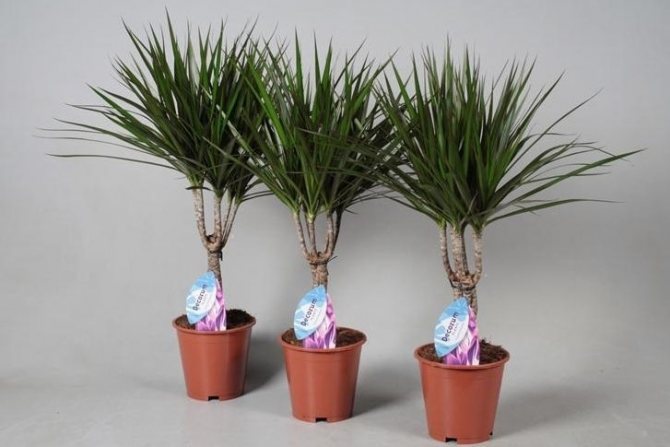

Dracaena Bordered
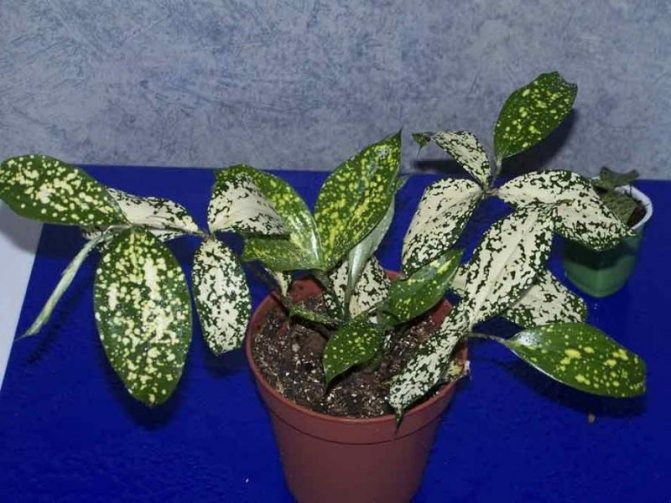

Dracaena Godsef
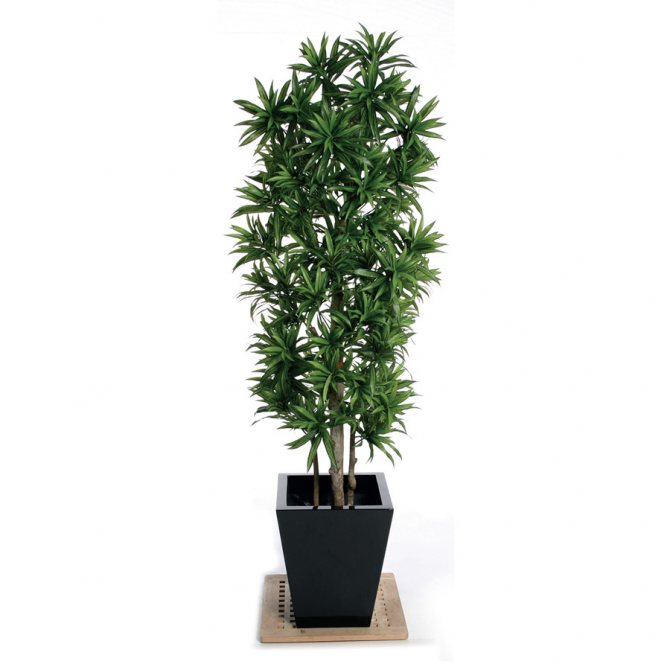

Dracaena Reflex
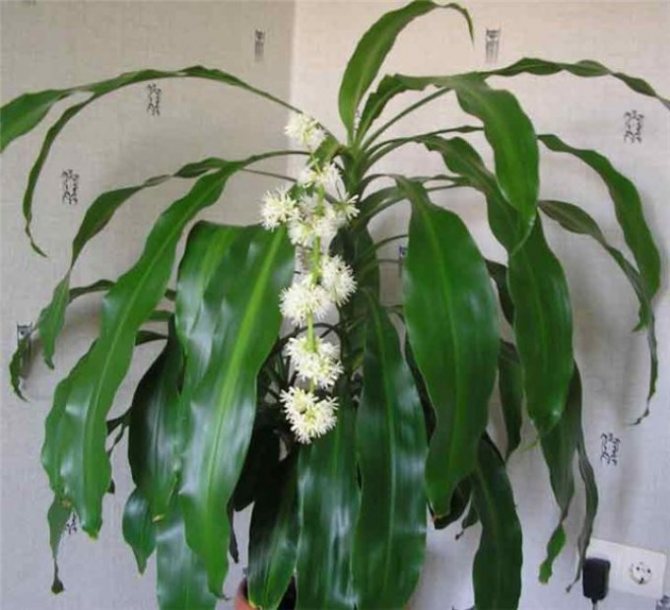

Dracaena Fragrant
Africa is considered the birthplace of the dracaena palm tree. It is in this place of the globe that you can find the largest number of representatives of this plant. Since the climate here is the most favorable for them, the dracaena growing in Africa, as a rule, are always very high. Lower species are found in India, South America and the Canary Islands. Palm trees growing in these territories are less picky, therefore, they are most often sold in our country.
When buying dracaena, you should take into account that it belongs to low-toxic plants, the juice of which can harm the human digestive system. When ingested, it begins to irritate the mucous membranes of the stomach and intestines, and against this background, a person may develop diarrhea, which will be accompanied by vomiting and nausea. And although you will definitely not die from this, it will still be better if you take measures that will prevent dracaena juice from getting on the mucous membranes of the oral cavity.
Types of dracaena palm:
- Dracaena Deremskaya (tall plant with characteristic white lines on the leaves)
- Dracaena Bordered (has long leaves, which are located at the very top of the tree trunk)
- Dracaena Godsef (looks like a bush with large spotted leaves)
- Dracaena Reflex (a distinctive feature is the presence of a treelike trunk and long curved leaves)
- Dracaena Fragrant (an adult plant blooms with beautiful white flowers)
Dracaena benefits:
- Removes formaldehyde, ammonia and carbon from the air
- Ionizes the air around itself
- Creates a favorable climate in the house
- Releases substances into the air that contribute to the health of people
Dracaena harm:
- May cause an allergic reaction
- Causes diarrhea when ingested
- Dust trapped on leaves can harbor dust mites
How to transplant
Dragon dracaena transplant should be done every 1-3 years. Small pots are preferable: this makes it easier to control the moisture of the earthen coma and avoid flooding the plant.
On this topic: How to transplant dracaena: after purchase?
For transplant you will need:
- a pot of a larger (2 cm) diameter;
- priming;
- drainage.
The transplant process is simple:
- pre-watered dracaena is removed from the old pot by tapping on the side walls of the pot and the bottom, the old soil is lightly shaken off;
- drainage (2-4 cm layer) and a small amount of soil are poured into a new pot;
- the plant is fixed at the required height;
- the pot is filled with soil;
- the transplanted plant is watered.
The right time for transplanting is spring. However, if the transplant is carried out by the transshipment method (without shaking off - damage to the earthen lump), it can be carried out all year round.
Diseases, symptoms, treatment
Although dracaena marginata is unpretentious in care, if the rules are not followed, it is affected by pests: scale insects, thrips, spider mites.
The scale insect affects the leaves and stems, which begin to turn yellow, slow down their growth. If no action is taken, the plant will die. In case of a strong lesion with a scabbard, the flower is treated with Actellik, in case of minor lesions - with a soapy solution with the addition of vodka or alcohol.
Small black insects - thrips infect the leaves, causing spots to form on them, the dragon tree slows down growth. A soap solution applied for 24 hours will help get rid of thrips, after which it is washed off. After a week, the treatment is repeated.
Spider mite damage occurs due to increased dryness of the air. Affected leaves turn yellow and fall off. Treatment of the flower with the preparation "Fufan", "Fitoverm" will help to get rid of the tick. Maintaining the required air humidity is a reliable prevention of spider mites.
Read also: Features of the fight against dandelions in the garden: how to remove the weed
Insufficient watering and increased dryness of the air can cause yellowing of the leaves, the appearance of brown spots, and their drying.
Drafts, too low air temperature also provoke the appearance of brown spots.
Direct exposure to bright sunlight causes burns on the leaves of the dragon tree. To avoid this, the flower is moved to another place or shaded.
Dracaena marginata, which is as easy to care for as other types of this exotic decorative flower, will become a real decoration of your home and office interior, bringing to it a refined atmosphere of the tropics.
Reproduction methods
How to propagate dracaena at home is of interest to all fans of this plant. Indoor exotic reproduces most effectively:
- apical cuttings;
- stem segments;
- air layering;
The best breeding season is the first two spring months. Reproduction in the summer-autumn period is fraught with a longer rooting process.
In the second method of reproduction, the stem is cut into segments with 2 buds, up to 7 cm long. Rooting is carried out by cutting the bark at the segments, sticking them into the soil, covering with a film. Also, as with the first breeding method, regular airing, spraying is carried out.
The third method is rather laborious and requires experience. After making a small incision on the stem of the plant, remove the bark from it. Place a little wet peat in a plastic bag, tie it to the trunk so that the place of the cut is inside the bag with peat. After a while, roots will grow at the site of the incision.When they appear, cut the trunk below the roots, plant a new plant in the ground. After a certain period of time, new shoots will appear on the cut trunk.
The most difficult process for breeding dracaena is reproduction by sowing seeds. Seeds are sown in a nutritious substrate, covered with foil. The first shoots appear after 30-40 days. The complexity of the process lies in the fact that this tropical exotic blooms extremely rarely in indoor conditions, it is very difficult to get seeds.
Meet the female dragon!
According to the Greek translation, dracaena means "female dragon". This name, she received due to the presence of dark red gum on the cracks of the trunk, something similar to the blood of a dragon. The plant has a very exotic deciduous system and a graceful thin stem.
According to some assumptions of scientists, the birthplace of dracaena is Africa, South America and the Canary Islands. The flower was first brought to our region from the Congo.
Previously, the dracaena had the name "bamboo of good luck", as many argued that it endows its owner with health and wealth, in general with this plant, many different signs and superstitions are associated.
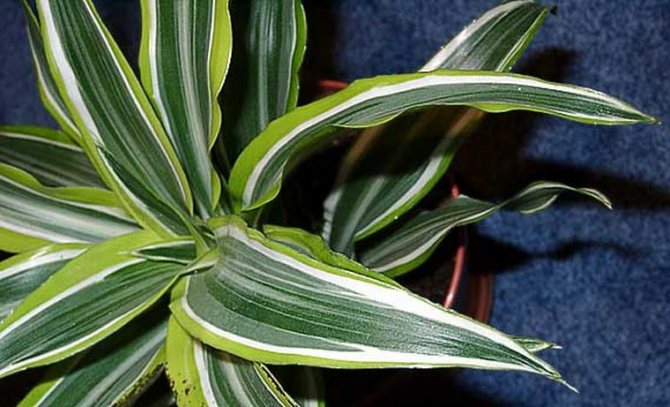

In the photo dracaena deremskaya
It is believed that a flower that is not given from the heart quickly dries up or withers. Also, if a new plant does not take root in the house and withers, it means that it has taken illness or trouble away from its owner.
Dracaena is considered the "flower of the family", therefore, according to the omen, a wilted flower can lead to its split.
The main types of dracaena
Although there are more than a hundred names of wild-growing dracaena, only about 15 are grown in indoor conditions. Depending on the species, these plants differ in the size of the trunk, the size and shape of the leaves, and color. The most common of them can be easily recognized in the photo, because it is dracaena that decorate both home and public interiors everywhere.
Dracaenasanderiana
It looks very much like bamboo stalks, but in fact it is not. Light green with woody "rings", the stems of this plant end at the top with oblong pointed leaves up to 25 cm long. The total height can reach 70-100 cm. It is believed that exotic Dracaena Sandera with its beautifully intertwined cuttings brings its owner happiness and luck in life ...


Dracaena deremskaya (Dracaenaderemensis)
It has long (up to 50 cm) narrow lanceolate leaves growing upwards directly from a wide, stiff trunk. The color can be either dark green or mixed, when in the center of each leaf there is a white-bordered strip of a darker / lighter shade than at the edges. The racemose red-white inflorescences that appear in the axils of the plant have a not very pleasant smell.


Dracaena fragrant (Dracaenafragrans)
It can grow to the size of a real home tree - 2.5 m with a strong trunk and large arched leaves (6-8 cm wide, up to 70 cm long) of a characteristic color. The name "fragrant" this dracaena acquired because of the tangible smell of freshly cut hay emanating from racemose inflorescences, which are usually cream or pink-greenish. This plant tolerates shade well and temperatures up to + 10 ° C.
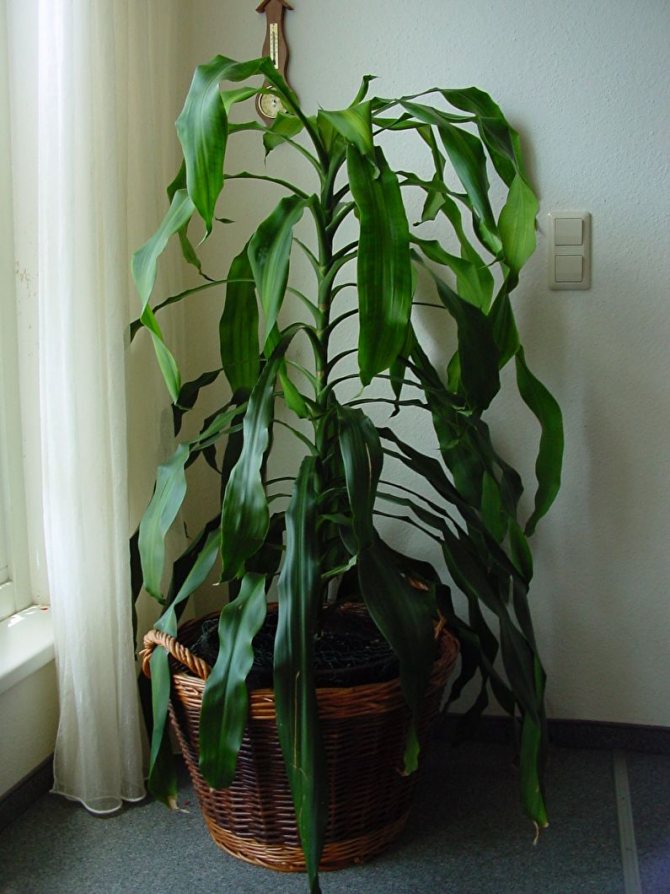

Dracaena unbent (Dracaenareflexa)
It differs in that its elongated (15-20 cm) and narrow leaves with a white or cream border, which are adjacent to the trunk in bundles, are slightly bent at the ends. This lush plant resembles a reduced tropical shrub, which makes it look very decorative in any setting.


Dracaena Godsef (Dracaenagodseffiana)
It bears little resemblance to its relatives: it has no trunk, and oval spotted leaves grow on thin branches directly from the ground. Chaotic yellowish-white dots on top of a green background resemble paint splashes, but there are varieties with a more sophisticated pattern.
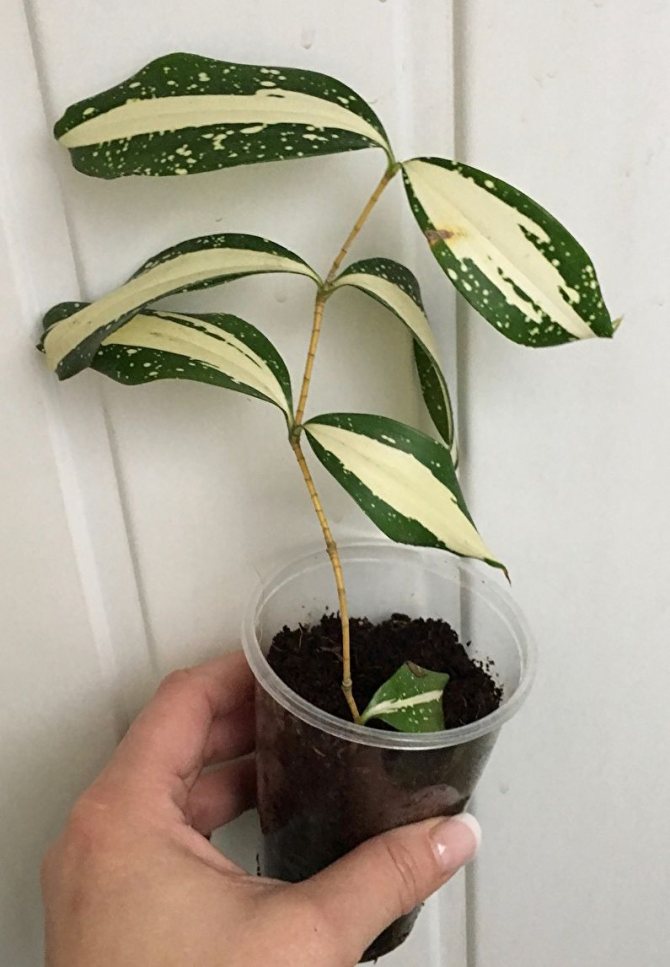

Dracaena Marginata (Dracaenamarginata)
It has the greatest resemblance to a palm tree among all other species. Its numerous narrow leaves are collected on a woody trunk in one or more bunches. This plant is one of the most unpretentious in lighting, loves shade and warm, humid weather.


Dracaena Janet Craig
A very beautiful tall palm tree with large, slightly wide leaves, which is ideal for growing in tubs. On a thin (up to 8 cm in diameter) green trunk, there are several lush branches at once. This is an extremely useful plant from the point of view of ecology - Janet Craig's dracaena and some other species perfectly filter the air, purifying it of harmful impurities and saturating it with oxygen.
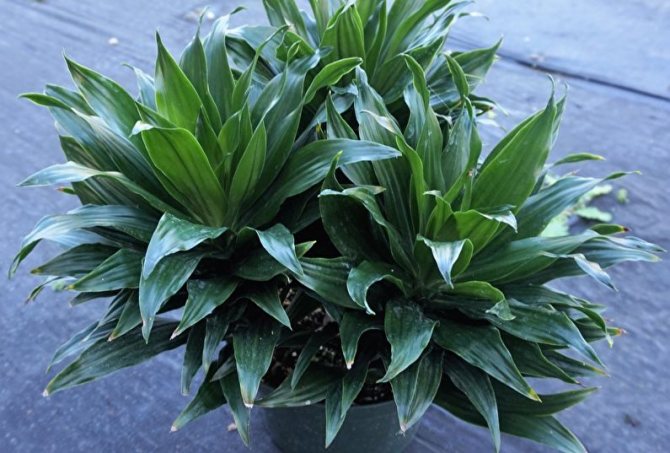

Dracaena transplant: technology


Before placing the palm tree in a new place, take it out of the old flowerpot. This is done very carefully, trying not to damage the fragile rhizome. If the plant is not watered for several days, it will be easier to get it out of the container. It is easier to separate the dried soil from the walls of the flowerpot. The plant is tilted upside down and gently slammed on the pot. Dracaena is taken out together with an earthen lump.
Actions during transplantation:
- Examine the rhizome for damage. Cut off injured roots with a clean knife or scissors.
- Treat the cuts with crushed charcoal. This is the prevention of further infection and decay.
- Spray the prepared rhizome from a spray bottle.
- Wash the pot with warm soapy water.
- Lay a drainage layer, on top - a layer of soil.
- Place the dracaena in the center.
- Fill in the soil, carefully filling the voids between the roots. Tamp the substrate near the stem.
It is not recommended to deeply deepen the palm tree. It will be more convenient to water the flower if you leave the sides. The soil is compacted by gently knocking the pot on the countertop.
Planting several dracaena in one container is allowed. Palm trees with small foliage are placed together to create interesting combinations. The main thing is that the size of the flowerpot is enough.
When transplanting dracaena, it is important not to injure the rhizome and equip drainage.
Dracaena "Bamboo of Happiness" does not look alone in a pot. Groups of 10 or more are formed from plants. You should not put adult flowers with powerful trunks in one flowerpot: the composition will look heavy.
Transfer after purchase
There is no consensus among amateur flower growers and there is no need to transplant room dracaena immediately after purchase. Supporters of mandatory transplantation are guided by the following arguments:
- the use of transport soil, in which false palms are most often sold at points of sale, negatively affect their condition, which is due to the high content of peat and the subsequent decay of the root system;
- flower pots in which dracaena are sold are too small and completely unsuitable for full growth and development;
- it is not possible to conduct a visual inspection of the root system, so it is very difficult to assess the quality of a houseplant.
Opponents of transplanting a purchased false room palm tree believe that the transport soils contain all the elements necessary for good nutrition, therefore, they are quite well suited for growing dracaena. It is believed that such a soil substrate has optimal lightness and therefore provides air access to the root system of the ornamental plant. Among other things, there is an opinion that when transplanted into a new soil substrate, the root system is damaged, which causes disease, and sometimes even the death of the culture.
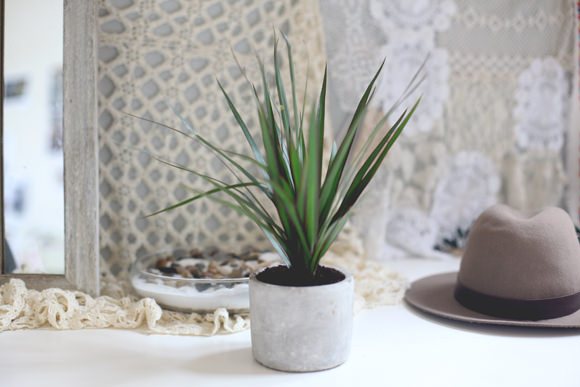

Nevertheless, according to experts, and as the practice of indoor floriculture shows, it is necessary to transplant dracaena after purchase. The transport soil is depleted very quickly, leaving the false palm lacking essential nutrients. The transplant technology is not complicated, but it is important to adhere to the basic recommendations:
- the new landing capacity should not be much larger than the one in which the dracaena was purchased;
- cleaning the roots from the soil is carried out only if the soil has begun to mold or sour, as well as if the root system has any damage;
- it is necessary to fill in a sufficient and high-quality drainage layer, which will prevent the accumulation of moisture and ensure uniform and high-quality drying of the earthy coma after irrigation measures.
Possible problems with the reproduction of dracaena
Despite the fact that dracaena is a completely unpretentious indoor flower, even experienced flower growers make some typical mistakes that lead to the death of the plant. The most common are:
- Excessive watering - you should not overmoisten the soil lump too much, as well as overdry it. Young plants are very sensitive to excess moisture, roots can rot and they die.
- Using used transplant and rooting containers - contributes to the spread of infection. When breeding dracaena, try to use only new pots.
- Long-term maintenance of the flower under the film - constant ventilation and weaning of the plant from the greenhouse are required.
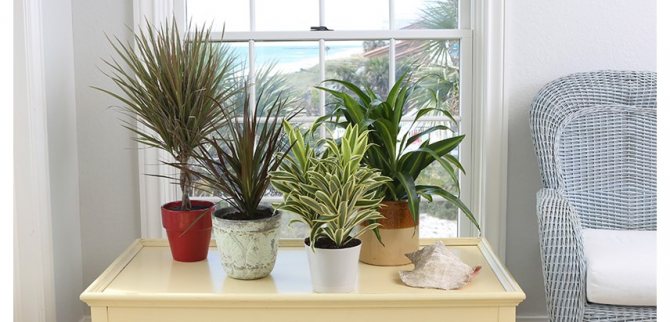

Compliance with all the rules leads to successful breeding.
Flowering and fruiting
Dracaena is a perennial plant with different heights, depending on its type and variety. In the wild, trees can reach heights of up to 20 m. The tree has a lignified stem, on which sessile long linear leaves are located, varying in width, length and color.
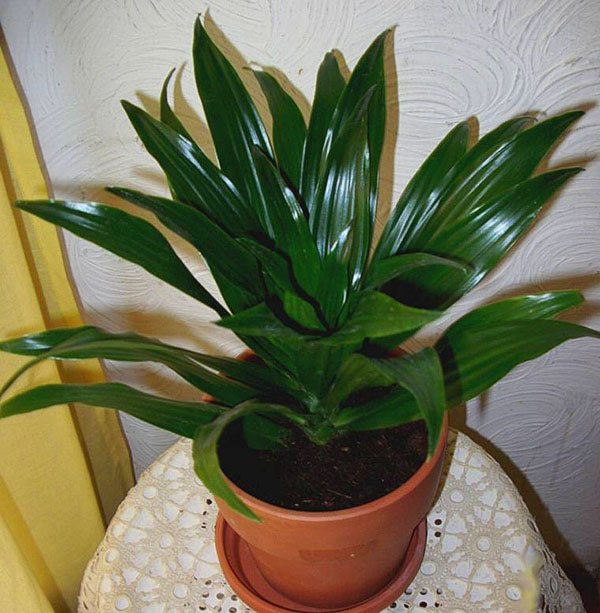

Older specimens are similar in appearance to palm trees. The roots are yellow-orange. Flowering occurs rarely, with small flowers collected in panicles. Inflorescences in some species are fragrant and differ in color: cream, white, greenish. After flowering, drupes are formed on the peduncles. Each of them contains one seed from one cotyledon.
How to propagate and transplant a flower at home
It is recommended to replant the plant in early spring. A young flower needs to be transplanted every 2-3 years, but a mature plant needs to be transplanted only after its root system completely fills the pot. In all other cases, it is sufficient to simply replace the topsoil.
With each flower transplant, the new container should be 3-4 cm larger than the previous one. As a soil, you can use a soil mixture of peat, coarse sand, compost, as well as deciduous and sod land, which are taken in equal quantities. You can also purchase ready-made soil for palm trees.


Dracaena root system
Transplant stages:
- Pour hot water over the pot.
- Place 3 to 4 cm of drainage on the bottom of the pot. Expanded clay, pebbles or fine gravel can be used as drainage.
- Remove the flower from the old container and examine the roots. Decayed plant roots must be removed with a sharp blade.
- Place the shrub in a new pot along with the old clod.
- Fill the voids of the container with the previously prepared soil.
- Compact the ground carefully.
- Water the plant liberally.
The photo will help you visually familiarize yourself with the stages of bush transplantation.
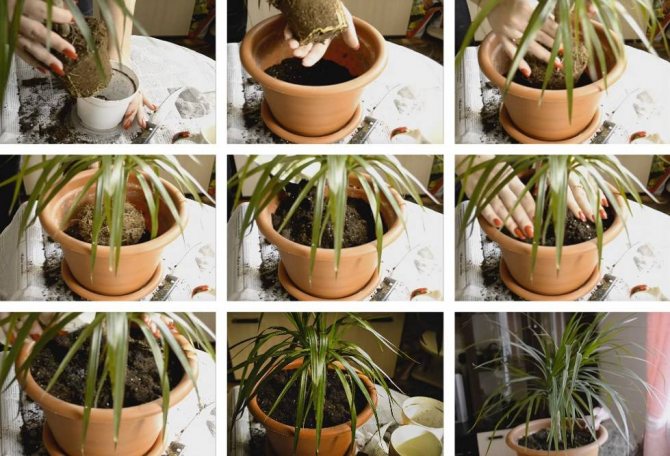

Transplant stages
Dracena, as a rule, is propagated by cuttings, since it is almost impossible to achieve the appearance of seeds by growing a flower indoors. The best and easiest way to propagate a shrub is in the spring or summer.
A cut off top of a tree or stem segments is used as a cutting. You can root the cutting in water with the addition of activated carbon or in a mixture of wet sand and peat. Some growers process the cuttings with phytohormones to speed up the rooting process. The stalk must be covered with a glass container or plastic bag on top to create greenhouse conditions.


Cuttings
The stalk, being in greenhouse conditions, acquires its roots within a month.After the roots appear, the cutting can be planted in permanent soil.
Pests and diseases
Usually, the pests attacking the dragonfly are scale insects, thrips and whiteflies. Rarely spider mites and aphids. The plant is quarantined, pests are removed and treated with special preparations (insecticides).
As for the diseases, the dracaena is affected:
- powdery mildew;
- brown, gray, brown and bacterial rot;
- fusarium, bacteriosis, heterosporosis;
- spotted wilting and some others.
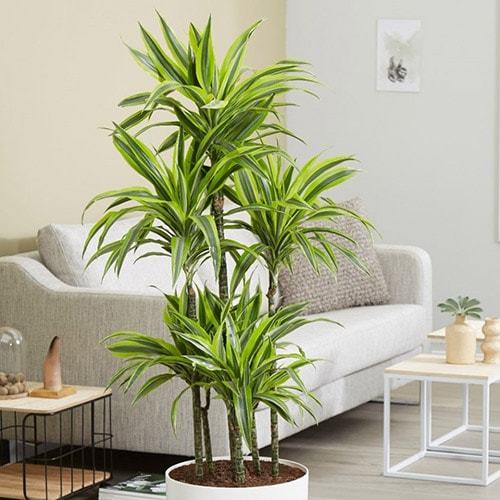

For treatment remove damaged leaves and areas, are treated with special solutions or transplanted. Each case is individual and sometimes take a long time. Be patient, follow the recommendations of experts, and you will be able to save your dracaena. In the future, follow the care tips, then many diseases can be avoided.
Signs and superstitions
It is good to place the tree of happiness at the entrance to the house, as a talisman of the owner and his family. The number of trunks matters: there should be 3, 5, 7, but by no means 4. This number is considered unlucky among the Chinese.
In the interior of the house, the plant will look good in the living room and bedroom, having a positive effect on the air and energy of the house. It is believed that the flower has the ability to turn the accumulated negative energy of the house into positive one.
Some signs associated with the maintenance and cultivation of the dragon tree:
- a sudden gift of a flower means luck in love;
- with the appearance of a plant in the owner's room, success and luck await, career growth and quick decision-making in business;
- bamboo of happiness brings peace and harmony to the family.
There are also sad, even scary omens:
- if the flower withers, then a person with negative energy has appeared in the house, or one of the household members has problems;
- the death of the tree of happiness means the death of one of the spouses. The appearance of the sap of "dragon blood" on a tree trunk means a violent death.
According to Feng Shui, the bamboo of happiness is a very useful flower. It is a symbol of matrimony and is presented for any occasion: wedding, New Year, family celebrations. It is better to place it in the wealth zone: on the south or east side of the house.
To protect against external bad energy, flower pots are placed on the western window. For greater effect, Feng Shui masters advise tying the trunks with a red ribbon.
Dracaena is an unpretentious and undemanding long-lived plant. Indeed, if placed correctly, it will be a family talisman for years to come. Phytodesigners advise placing the flower in a prominent place in the room - on the floor or on low stands, using several varieties at once with different crown shapes and leaf colors. The priority number in the Dracaena group will be 3 or 5 plants.


Dracaena dragon (Canary) grows in tropical and subtropical regions of Southeast Asia, as well as Africa - including the Canary Islands.
Origin of the name This tree is associated with an ancient Indian legend, according to which a bloodthirsty dragon once paid for his addiction to warm elephant blood: a huge old elephant, dying, crushed a cruel predator.
The blood of both giants, mixed, gave life to the growth of trees unseen until then: with mighty, like elephant's legs, trunks, bunches of leaves as sharp as dragon's teeth and blood-red resin.
The soil
For bordered dracaena, a nutritious and moisture-absorbing earthen mixture is needed, which includes turf, leaf, humus soil and peat in a ratio of 2: 1: 1: 0.5. If the store does not have a ready-made suitable earthen mixture, then you can make it yourself. When transplanting, do not forget about drainage. The drainage layer should be about three centimeters, or at least ¼ of the height of the pot.
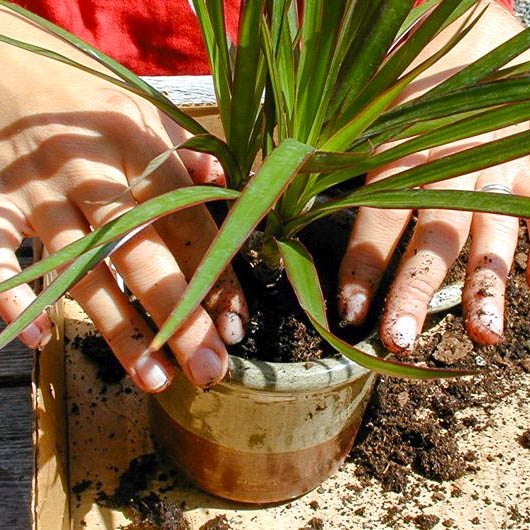

The history of growing a tree of happiness and signs
The first botanical description of the plant was presented by Carl Linnaeus in 1767, who in his works relied on the works of the Italian scientist Domenico Vandelli. According to the description of sailors, in 1942 an old tall tree of exotic shape was seen on the island of Tenerife, which was considered sacred by the locals, and they worshiped it like a deity. Dracaena began to be grown at home in the 19th century and since then the plant has not lost its popularity among gardeners.
Several legends are associated with the history of the appearance of the genus Dracaena, which explain the name of the plant. According to one of the legends, the first dracaena grew out of the soil, which was saturated with the blood of a dragon and an elephant as a result of their battle. But in the countries of Latin America it is called the tree of happiness, because, according to one of the legends, dracaena brought good luck and happiness to a young couple of lovers.
It is believed that the tree brings family happiness and love to the home where it grows. For this reason, the plant is perfect for single people who dream of a prosperous family life. There is also an opinion according to which the quality of love relationships can be determined by the growth rate of flower leaves. If the leaves grow steadily and quickly, then peace and love reign in the family, and the slowdown in their growth suggests that the relationship should be worked on.
Fragrant dracaena got its name from the sweet aroma of its white flowers. According to the signs, the flowering of a tree portends material luck or career growth, but it should be borne in mind that it rarely blooms in home conditions.
Characteristics of the species
Dracaena is a popular decorative culture from the Asparagus family. In its natural habitat, the shrub grows up to 6 m in height, when indoors its growth rarely reaches even 2 m. It has a thick, erect, stiff stalk of light brown color, from which several branches extend. However, in a plant grown indoors, the stem is rather unstable and requires additional support.
Curved glossy leaves of a shrub are located at the top of its crown alternately, gathering in a socket. The length of the lanceolate rigid leaf plate can reach 60 cm, but its width, as a rule, ranges from 1-10 cm. The leaves of the bush can have a monochromatic green or two-color color. White, yellow or dark green longitudinal stripes are clearly distinguished on two-colored leaf plates. As the tree grows older, it loses its lower leaves, and its trunk becomes bare.
In the wild, an adult dracaena boasts an annual lush bloom, but you should not expect white-green flowers to appear on a plant that grows indoors. The flowers of the bush exude a pleasant aroma, reminiscent of the smell of freshly cut grass, after which the plant was named. The flowering of the shrub results in the appearance of small orange fruits of a round shape.
Dracaena palm grows poorly: what to do?


Sick plant
There are times when dracaena completely refuse to grow and even regular feeding does not help to solve this problem. As a rule, in this case, the reason for the slow growth of palm trees is not quite proper care. In view of this, the first thing you should do is simply move the flower to a different location.
Quite often, even such a simple measure helps the plant to begin to develop more intensively. If this does not help either, pay attention to watering. Try pouring soft water on the dracaena, or better yet, rainwater. If you want, you can try adding oxalic acid to the water, which stimulates the growth of indoor plants.
But remember, this substance, in excess, can be harmful, so it will be better if you alternate ordinary watering with watering with oxalic acid.Another reason why dracaena will refuse to grow is a small pot. In view of this, try to transplant the plant in time, be sure to remove all the old soil from the roots before bringing it into a new container.
Description
Indeed, the dragon dracaena - very powerful and long-lived plant, in natural conditions, reaching a height of 20 m and growing again in width to a thickness of 4 m at the base.
Each branch ends with a dense bunch of narrow, long, sharp gray-green leaves.
If you cut the bark, a colorless juice-resin will come out, which in the air quickly acquires a rich blood-red color and therefore is called "the blood of two brothers" (according to legend) or "cinnabar" (which itself means "dragon's blood"), and is also endowed with a special healing and magical power.
In room culture dragon dracaena retains both a slow perennial development, and an exotic shape of the trunk, and bunches of sharp leaves, and resin-blood, but does not grow above one and a half meters.
You can listen to a more detailed description in the next video.
Legend
In the homeland of the tree, there are several legends about its origin. According to one of them, dracaena was born after the death of a powerful ancient dragon. These huge wise creatures possessed magical blood that allowed them to live for several thousand years. She got rid of all diseases, instantly healed wounds. People began to kill dragons, but the miracle cure obtained in this way immediately lost its power. The blood of the last badly wounded dragon was soaked in the earth. Trees have grown in this place. Their trunks have absorbed blood. This allowed, finally, people to use the gift of life for which they have been hunting for a long time.
Drops of sap released when the trunks are damaged are so frighteningly similar to blood that in the Middle Ages these trees were seriously considered semi-animals.
Reproduction
Dracaena propagates by cuttings. Carefully cut off the top of the flower at an angle with a sharp blade. The length of the cutting should be at least 10 cm. Make sure that the cut is even, otherwise it is more likely that the stem will rot rather than take root. After cutting the cutting, you can leave it to dry for several hours, but if there is no time to wait, you can immediately start planting. The water in the container where you lower the cutting should be at room temperature and previously settled. You need to change the water as it gets dirty, this is about 2 times a week. A little trick: so that the water does not become cloudy very quickly, 1 tablet of not crushed activated carbon is added to it.
The process of putting down roots in Deremskaya is quite long and will take at least 2 months. To speed up this process, you can add a little special rooting agent to the water, they are sold in any flower shops. This will help speed up the rooting process by about a week and a half. For grafting, use only a young, strong plant, otherwise the shoot will be weakened and will not be able to take root. When the little dracaena takes root, it can be transplanted into a separate pot.
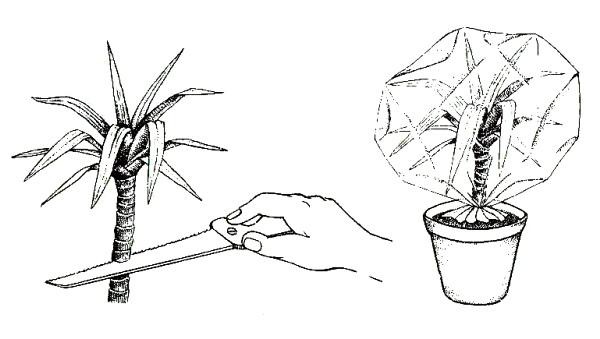

Propagation of dracaena with an apical cut
Care should be more thorough than for an adult plant. Make sure that the temperature does not drop below 24 degrees, and there is enough bright diffused light. You can create a mini greenhouse by covering the plant with a transparent bag. It is worth watering as the top layer of the earth dries out. Spray the leaves at least 4 times a day with warm, settled water.
Sometimes it happens that the top of the plant is rather sluggish or has completely disappeared, then the way to propagate the dracaena by stem cuttings is perfect. To do this, select a healthy stem and cut into pieces 10 cm long. It is imperative to cut along the leaf scars. Make sure the tool is very sharp. It is advisable to root such a stalk in the sand.Housing conditions are best suited in a greenhouse, with high temperatures and frequent spraying.
Seed propagation is also possible, but it is only suitable for a species with green leaves, since variegated forms can lose their varietal differences. Seeds should be sown in early to mid-spring. The germination process takes about 6 weeks.
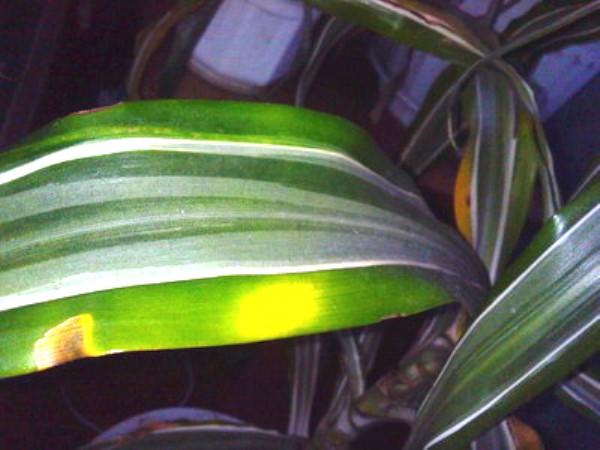

Description of the dragon tree and its characteristics
This type of tree is relict. It looks like a large cactus. Possessor of sharp foliage. The resin has a red tint.
This culture has 150 species.
A big feature is the juice, which is clear at first, but when exposed to air, it takes on a scarlet color.
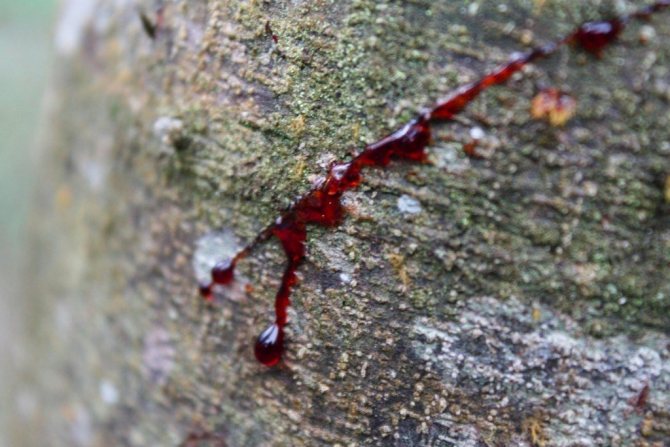

This is due to the pigment: Dracocarmine and Dracorubin.
When the juice hardens, it becomes a thick compound that resembles glass. The juice can be used to make paint and varnish. Previously, the juice was exported from the islands of Tenerife and Socotra.
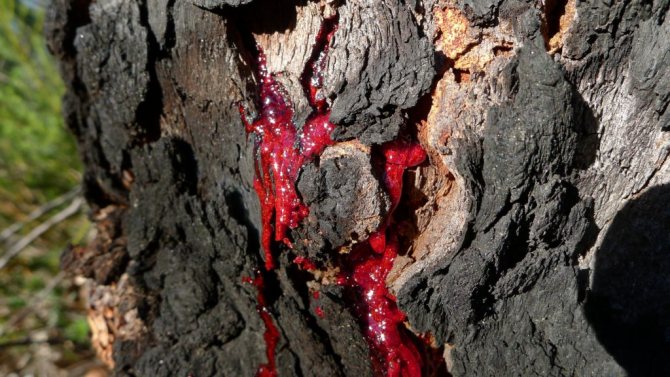

There are several stages that are not related to each other:
- The first stage of the tree is adolescence.
- The second stage is maturity.
- The third stage is old age.
More about adolescence... It lasts up to 34 years. After the stage comes to an end, the plant begins to bear fruit.


Twigs form instead of scars on the tree.
Old age stage includes the release of resin. The tree has no rings by which to determine its age. It is thanks to this feature of the tree that it is very difficult to determine.


Benefits of the dragon tree
The Canary people consider this tree to be sacred. They were treated with her resin.
- It helps with internal bleeding and also helps to cure diseases associated with the immune system. The resin can cure stomach ulcers, furunculosis, skin diseases.
- Resin can be used to stop bleeding.
- It works great as a disinfectant.
- The resin can also be used for cosmetic purposes. It has a positive effect on anti-aging properties.


Dragon tree plant: growth spots
One of those most famous trees grew exactly in the Canary Islands.
The growth of this tree is 21 meters.
The diameter of such a tree is 13 m.
The tree can grow and develop for about 6000 years.
Interesting. This specimen has not survived to this day. In 1868, a violent hurricane killed the relic. The plant grows in Africa. The islands of Asia have also harbored culture.
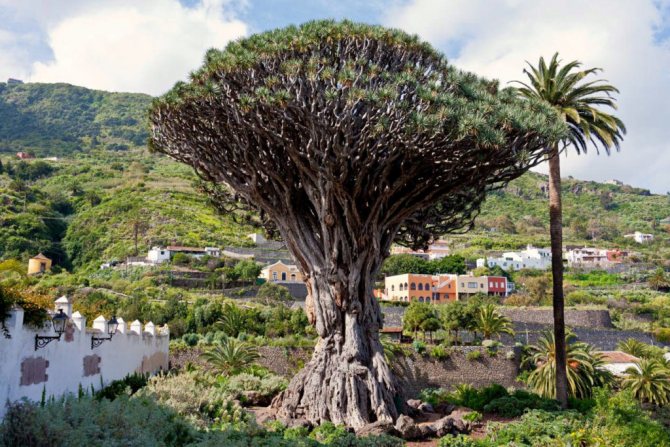

Now the oldest tree is the one that grows on the island of Tenerife.
This tree is about 3000 years old.
In 1917, culture was considered an important monument of national importance. This is the symbol of this island.
About 6,000 tourists come to the island to see this natural wonder with their own eyes.


It is located in a park called "Drago". The height of this tree is amazing, it reaches 25 meters in height, its coverage is 10 m.
Interesting. You don't even need to talk about the weight of this tree. Since it weighs approximately 80 tons. The cultural monument is surrounded by the park, which occupies about 3 kilometers in a square. There are many cultures and endermiks in this area.
The tale of a pretty tree


When people hear the word “legend,” they immediately know that part of the story is fiction. A similar thing happened with the name of the dragon tree. One of these legends tells of a bloodthirsty dragon who often attacked huge elephants. He drank all the blood out of them, giving no chance of salvation. One day, a defeated elephant fell on its killer and crushed him with its body. As a result, blood began to flow to the ground. Over time, amazing trees have grown on this site, which are called dragon trees.


Another story about the tree is related to romantic relationships. On the South American continent, the plant is called the "Tree of Happiness" and this is no coincidence. In one Aztec settlement there lived a brave but poor young man.He fell in love with the daughter of the chief priest of the tribe, who also had tender feelings for him. Then he asked the priest for the hand of his dear daughter. But the rich nobleman did not like this. He grabbed a stick, which was prepared for the sacrificial fire, plunged it into the ground and ordered it to be watered for a whole week. If leaves appear on her, he is ready to marry them.
The young man realized that he had lost the girl forever. Nevertheless, he decided to fulfill the request of the priest, hoping for a miracle. When the specified period came to an end, young leaves appeared on the stick. The story ended with a wedding, and the plant was named the "Tree of Happiness". Some people still believe in the miraculous power of the mysterious plant.
The dragon tree is often called dracaena, which means “female dragon”. The plant is widely used as a home grown indoor crop.
Why is the dracaena palm called dragon, dragon tree, tree of happiness, can it be kept at home?
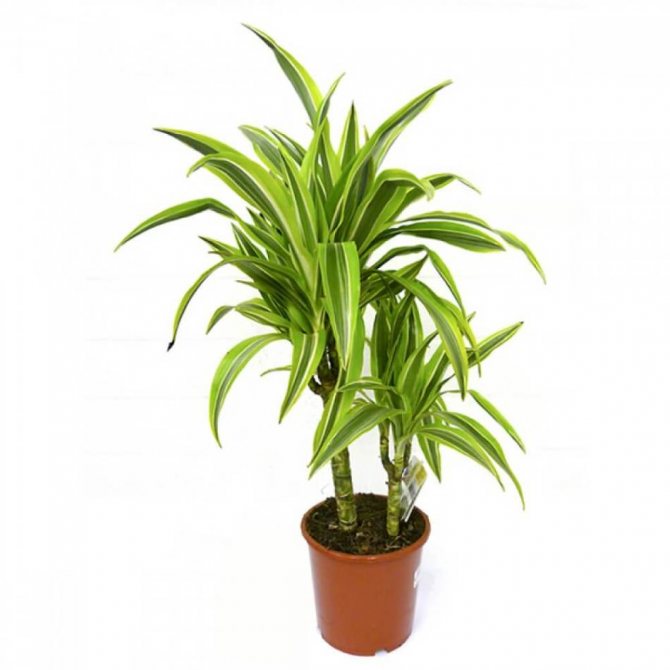

Dracaena - tree of happiness
Dracaena palm has several names, so if you are offered to buy a dragon tree or a tree of happiness, know that this is it. Why is it called that? The Latin word dracaena, translated into Russian, means dragon, so a large number of flower growers prefer to call this plant a dragon tree. As for another popular name (tree of happiness), it is associated with a very romantic legend. A young guy fell in love with a very beautiful girl and invited her to become his wife.
She agreed to the marriage, but her father categorically refused to give his beloved daughter to a poor young man. And in order to prevent the wedding from taking place, he came up with a task that, as it seemed to him, the young man would never be able to complete. He stuck an ordinary dry stick into the ground and said that he would allow his daughter to marry only if she became a wonderful plant. Out of desperation, the young man began to water the stick every day, and on the fifth day it was covered with beautiful green leaves. As a result, the lovers got married, and the dracaena became the guardian of their family happiness.
And as for whether it is possible to keep the dracaena at home, then we can definitely say that this decorative flower should be in every home. Dracaena palm is considered a natural peacemaker that is able to relieve the atmosphere in the house. For this reason, it is very often placed in living rooms or kitchens, thereby trying to help households not quarrel among themselves. Astrologers, in general, believe that this plant is able to positively influence people and help them cope with fears and problems.
The main types of plants and its varieties
In the wild, the most common is the Canary dracaena.
Dracaena Rumph, Dracaena shoots and Dracaena Godsef are often found in private collections and botanical gardens. Indoor plant lovers often grow the following types of dracaena:
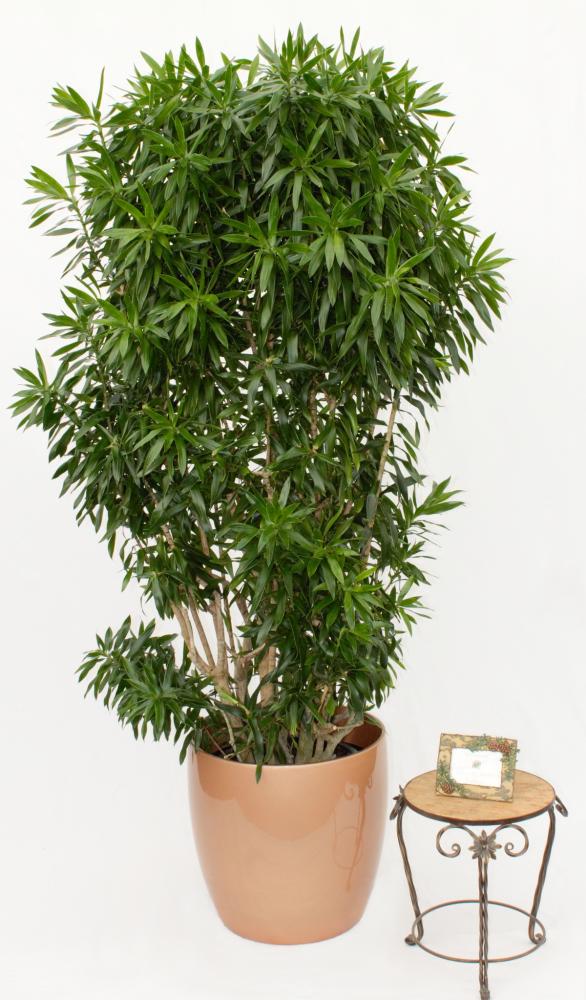

- bordered (Dracaena marginata);
- fragrant (Dracaena fragrans);
- capitate (Dracaena phryno>
How to correctly position the dracaena palm in the interior according to Feng Shui?


Dracaena in the interior according to Feng Shui
Those who are fond of Feng Shui firmly believe that if you correctly position the dracaena palm tree in the house, then it can protect his household from everything bad and attract good luck to them. If you want to check if this is really so, then buy yourself several representatives of this species. Two large dracaena will need to be located at the main entrance. Large palms will play the role of guards who do not let the negative into the home. Also, be sure to place a few smaller dracaenas in your living room and kitchen.
They will cleanse the common areas of households from negativity and help ensure that mutual understanding always reigns in the family. But in the bedroom of a small child, it is better not to put a dracaena.Since she has a very mobile energy, her presence will interfere with the baby's concentration and because of this he will not bring his own from the beginning to the end.
Botanical description of the plant
In nature, the species grows up to 20 m tall. The trunk is 4 m in diameter, strong, silvery-gray, additionally growing in width due to meristematic cells. When the bark is damaged, a red resin, called dragon's blood, appears, which becomes more pronounced in air. Wood does not form tree rings, so the age of the plant is difficult to determine. The trunk begins to branch out as it grows. The root system is developed, in nature it keeps the tree even on rocky slopes in strong winds. On the cut it has an orange color.
Dracaena Dragon has an umbrella-shaped crown. Leaves 60x4 cm in size, xiphoid, tapering at the base, pointed at the tips, hard, bluish color with prominent veins. Collected in apical rosettes. The flowers are small, with 6 petals, a simple perianth, bisexual, actinomorphic. An adult perennial bears fruit with edible orange berries that taste similar to sweet cherries. The life span of a dragon tree in natural conditions is 5-6 thousand years.
Biological characteristics of the plant
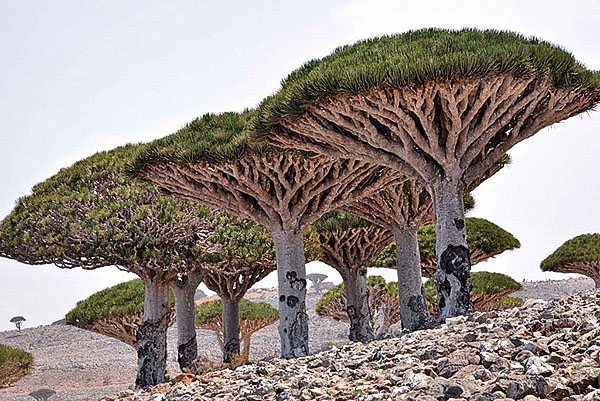

A detailed description of the dragon tree helps nature lovers to imagine the plant in all its glory. It can rightfully be considered a cute giant, because it reaches 20 m in height. The main feature of the tree is a branched trunk, which is often up to 4 m in diameter. Its wide crown consists of many thick shoots, densely intertwined with each other. On each of them, grayish-green leaves of a xiphoid shape grow. They are striking in their length - about 60 cm. The surface of the leaf plate is decorated with sinewy patterns that remind of a living creature from the legend.
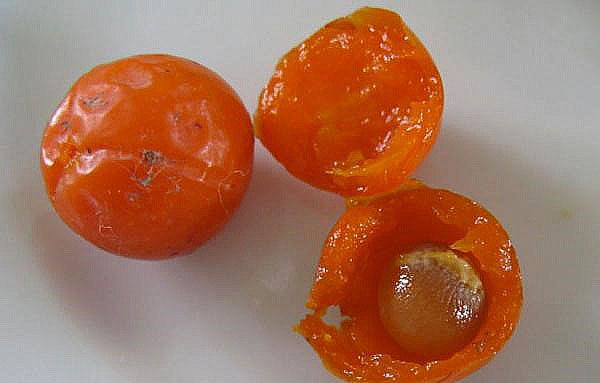

Like all plants, the dragon tree is crowned with flowers once a year. They are collected in small bouquets, which can contain from 4 to 8 buds. The flowering period lasts about two months - from July to September. After successful pollination, orange fruits develop in place of the buds.
Interestingly, the tree of happiness develops very slowly. It is almost impossible to determine its age, since there are no annual rings inside the trunk. Despite this, biologists note that the lifespan of a plant can reach up to 9 thousand years.
At first, only foliage is formed on the young shoots of the tree. Only 35 years later, the trunk begins to branch out, forming shoots with dense bunches of leaves. From the outside, they resemble an open umbrella.
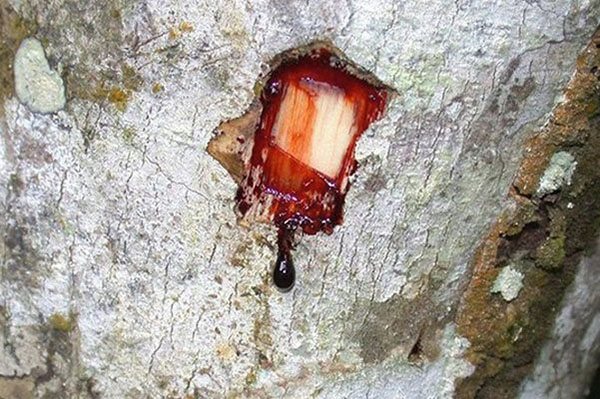

When the tree is about 100 years old, it produces a sap of a resinous character. Under the influence of oxygen, it acquires a reddish color. The people call the resin "dragon blood". It is famous for its many beneficial properties and is widely used for various purposes. Here is some of them:
- Natural fibers from sheet plates are used to create ropes and thick fabrics.
- Wood has a high heat capacity. It burns almost without fire, while generating a lot of heat.
- The sap of the plant is used to make varnish, which is used to cover metal surfaces or joinery.
- On the basis of the juice of the dragon tree, a dye for hair of a golden hue is made.
- The indigenous people of the area where the exotic tree grows use its juice to paint over their own alcoholic beverages.
- Alcohol tinctures are used to heal wounds and resolve bruises.
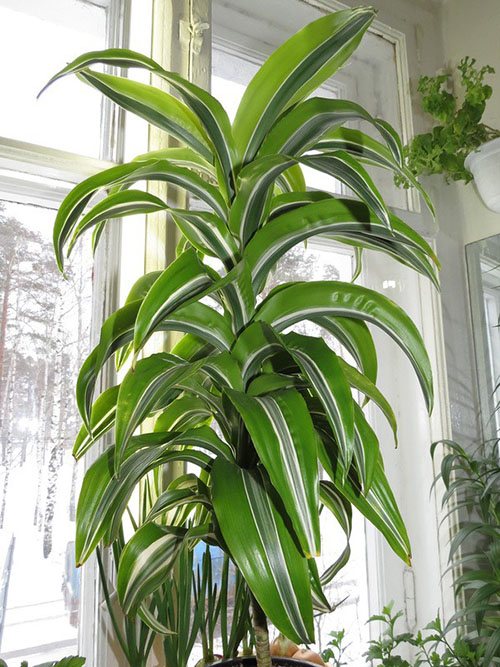

From this it is clear that the plant brings many benefits to humans. But, someone may object: "We do not have such trees, and you can admire them only in a photo or in television films about nature." In fact, many gardeners have long been growing a dragon tree at home, sweetly calling it dracaena.This close relative is as good as her majestic ancestors. In addition, there are many varieties of indoor exotic flowers.
Why is dracaena dangerous?
No scientific confirmation of the danger of dracaena when keeping a house has not been found. There is no poisonous sap in it, all parts of the plant are absolutely harmless. A cat that has chewed dracaena leaves is in no danger at all, however, and there will be no benefit either.
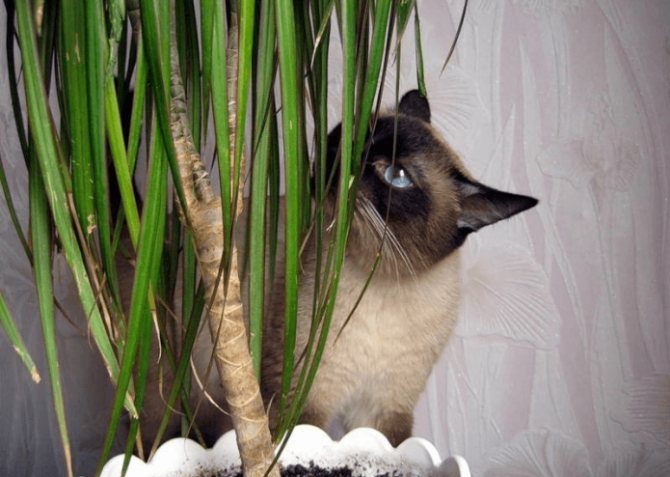

Dracaena is completely safe for cats
In addition to excellent decorative qualities, this culture purifies room air, absorbing toxins and various harmful impurities, and also disinfects it, destroying pathogenic microorganisms that can cause intestinal disorders and lung diseases.


It is best to place the dracaena in the bedroom or living room.
According to some reports, the active substances released into the air by dracaena strengthen the musculoskeletal system and promote the fastest healing of skin wounds.

